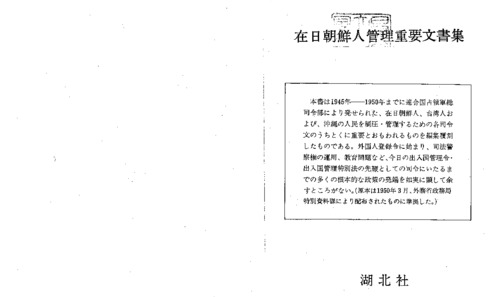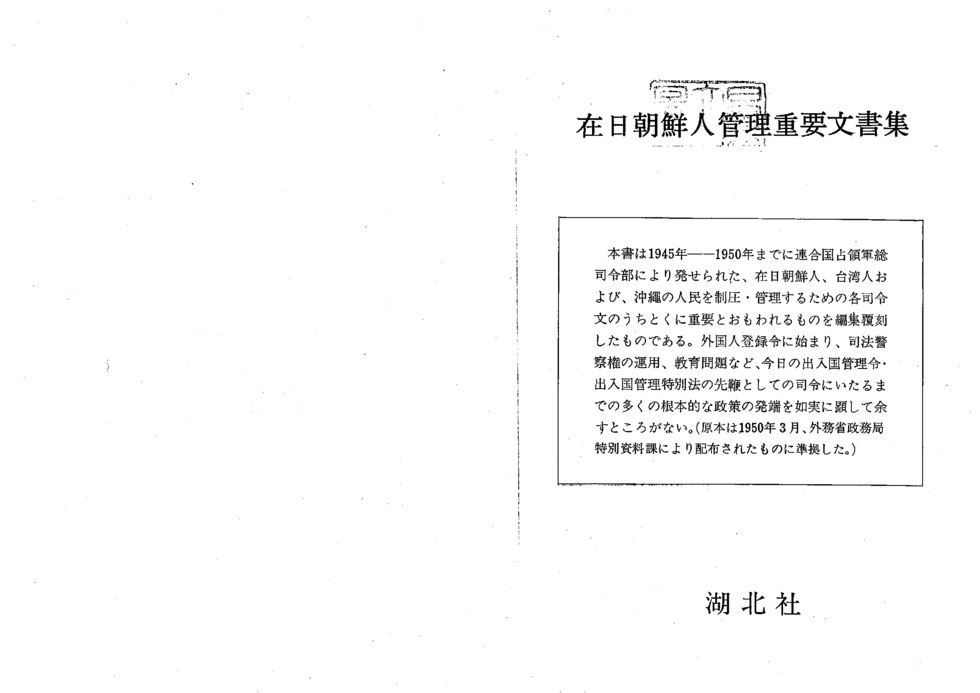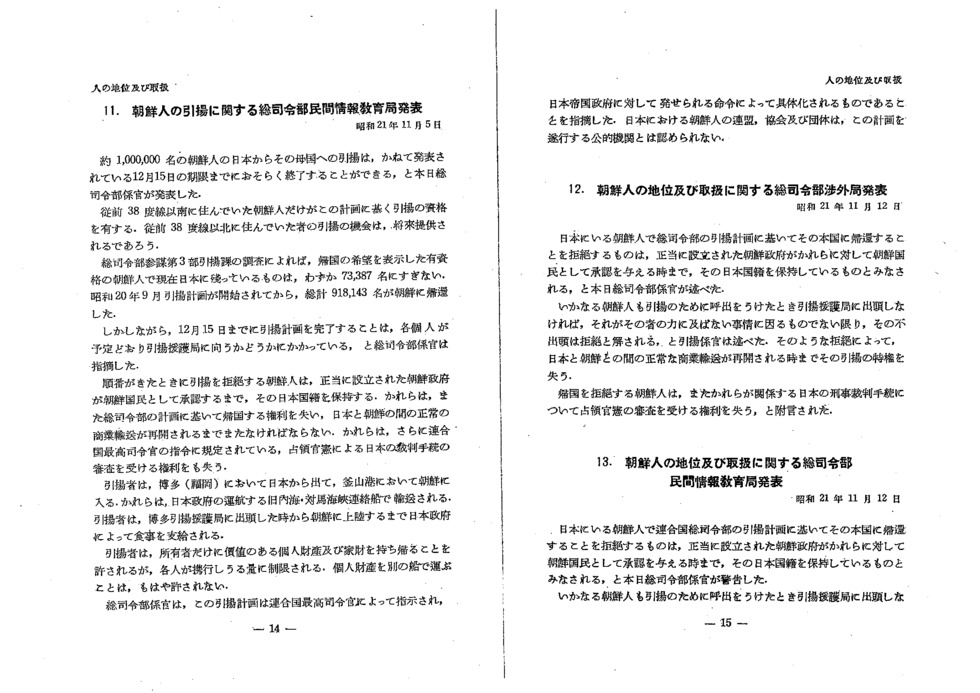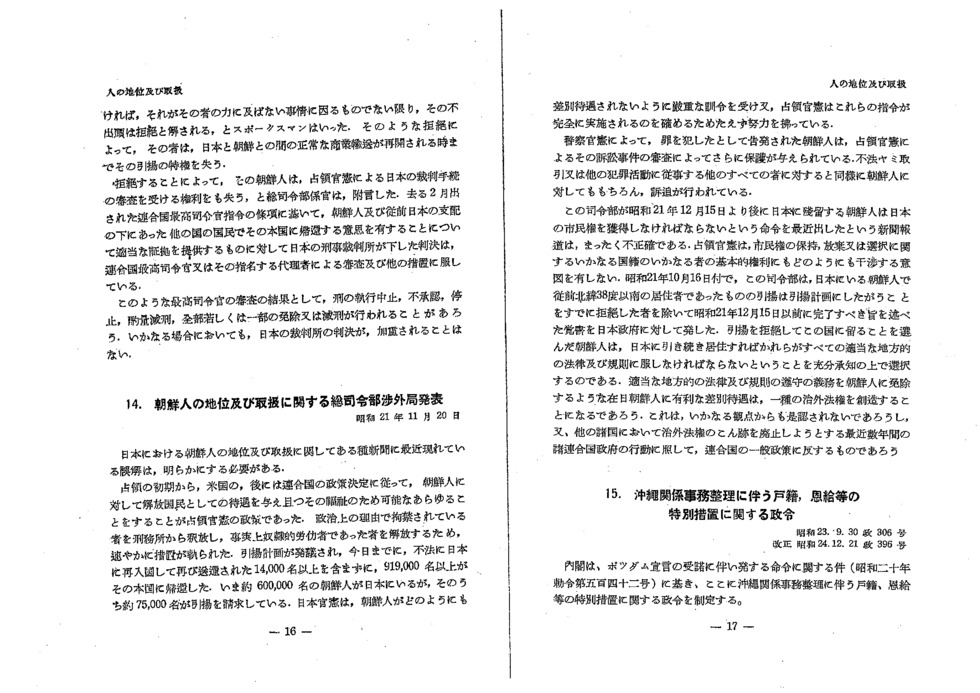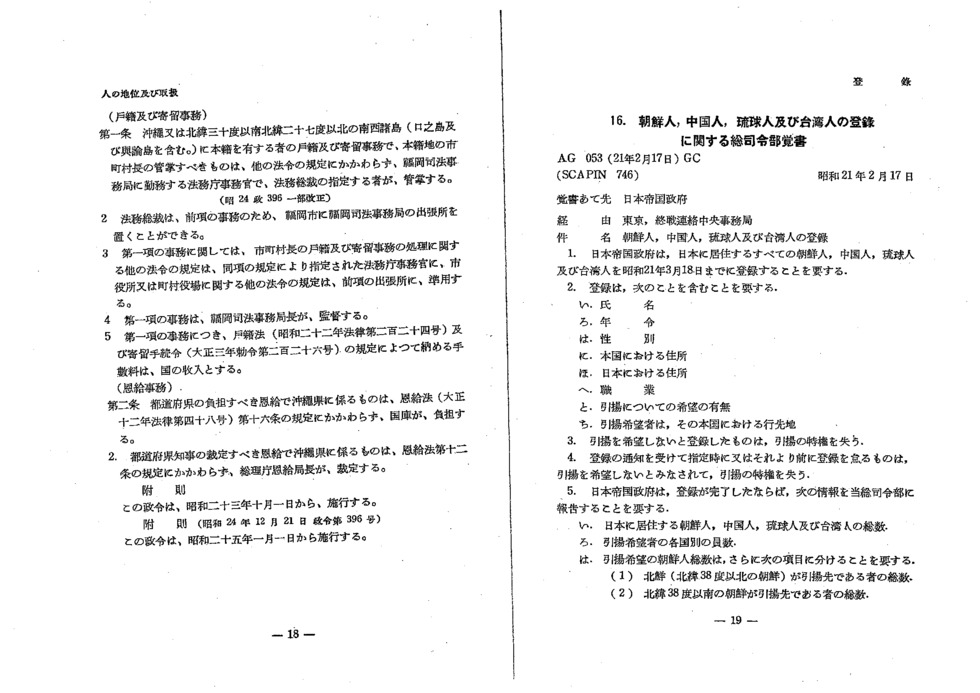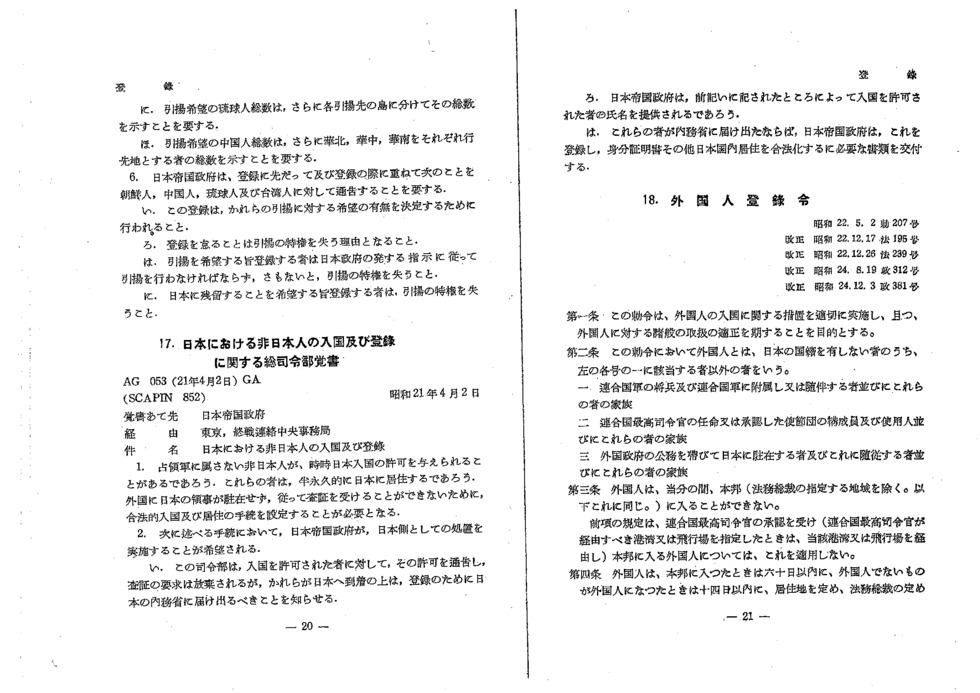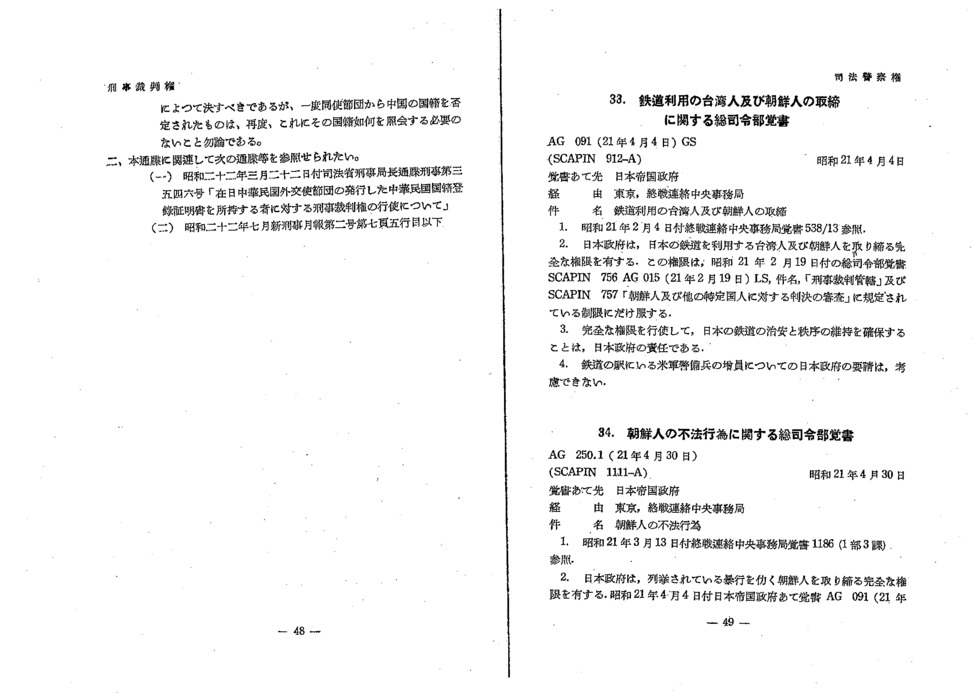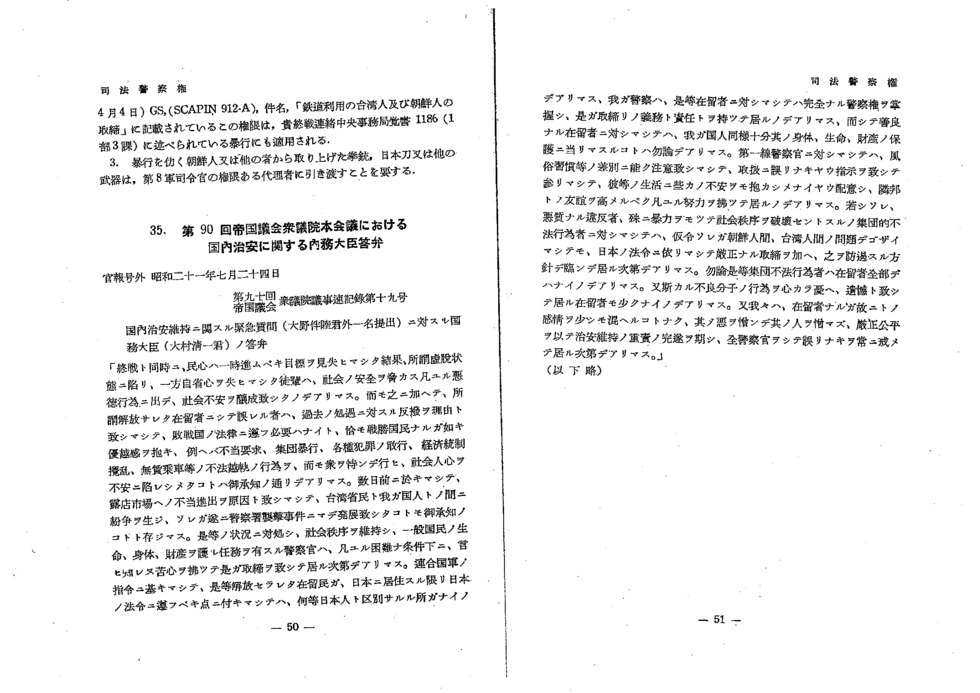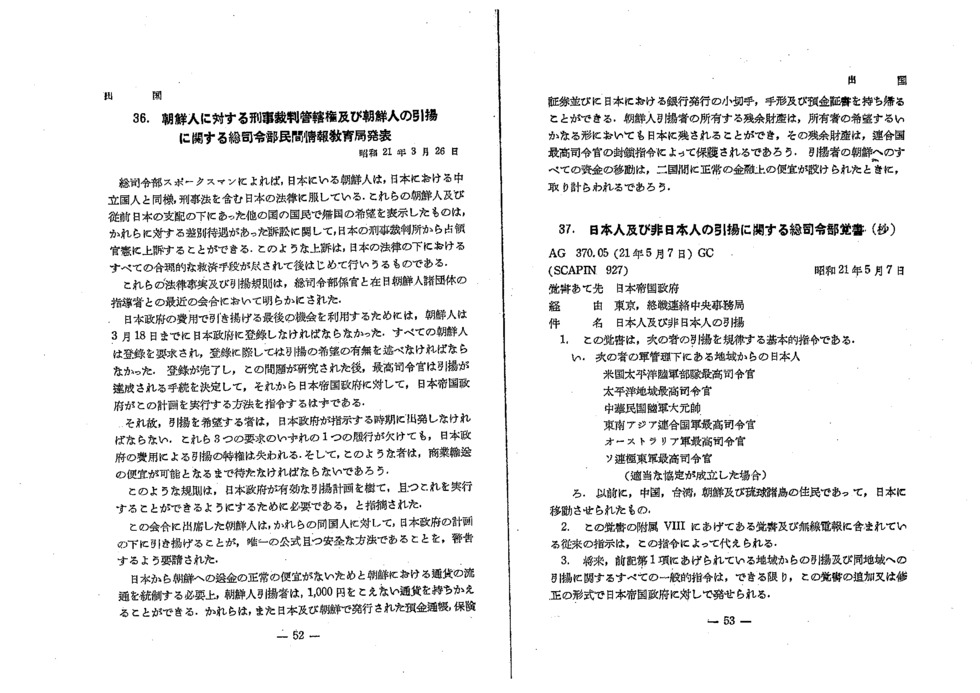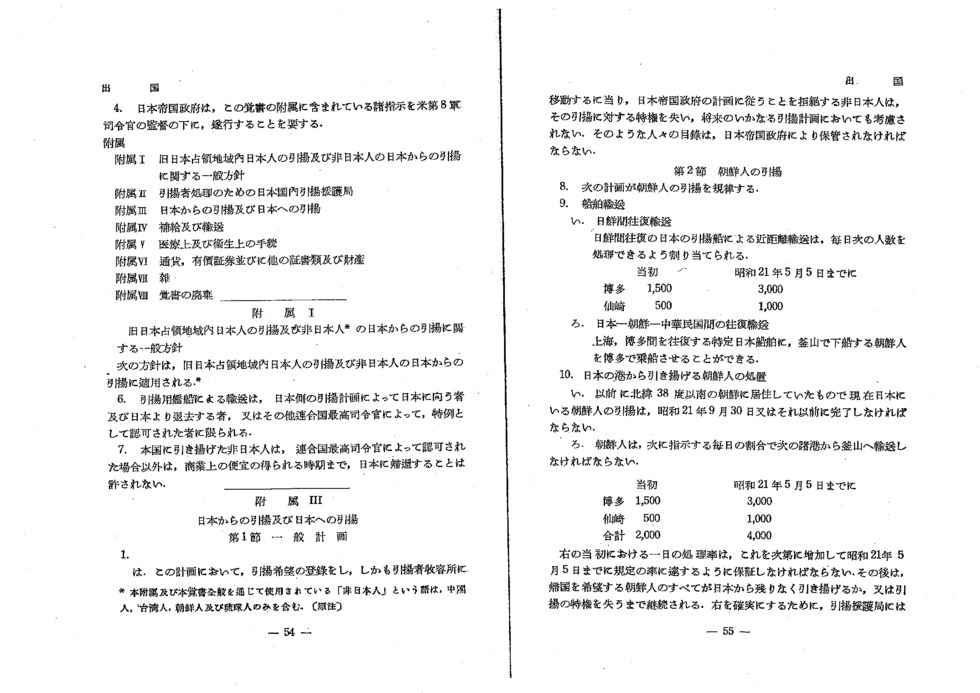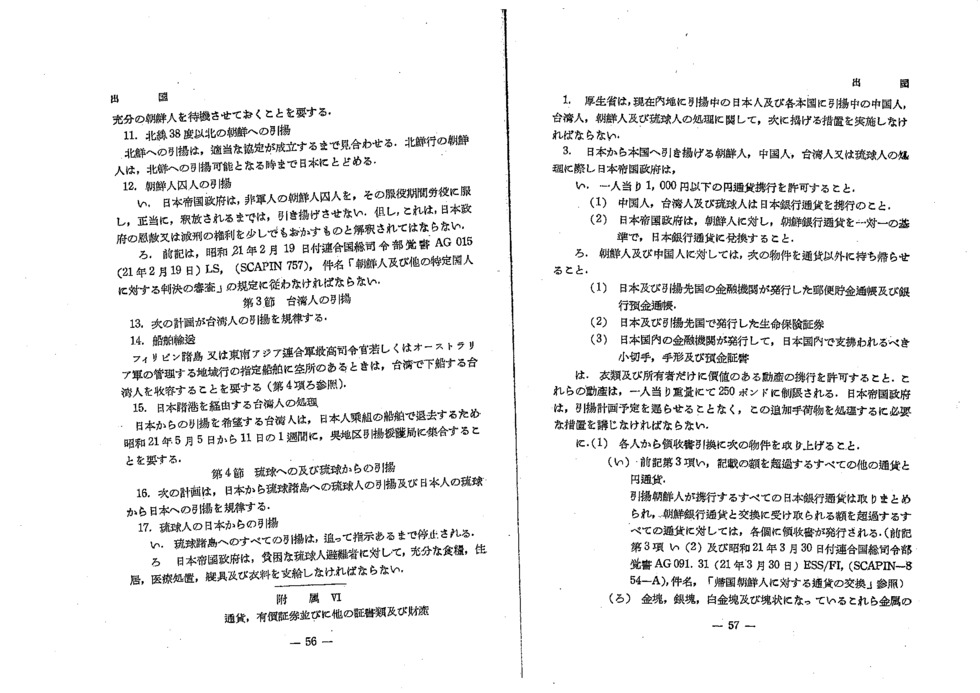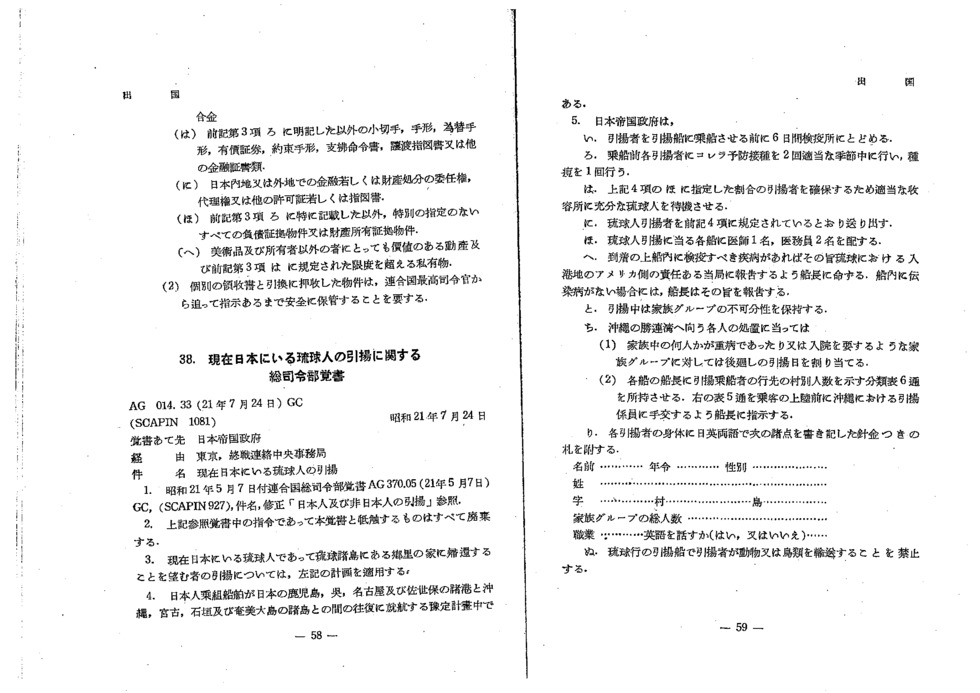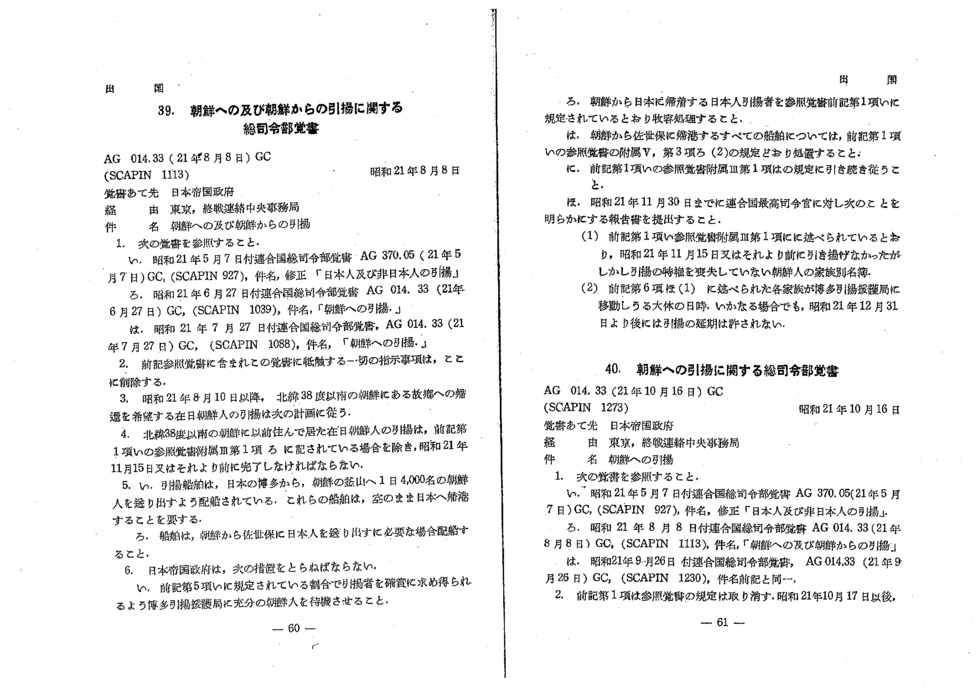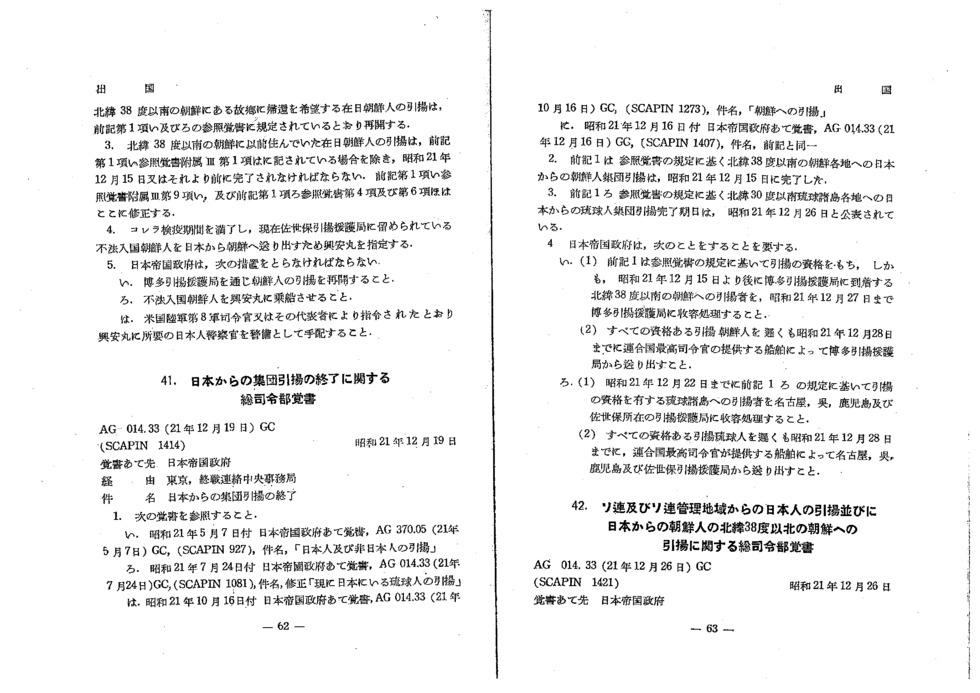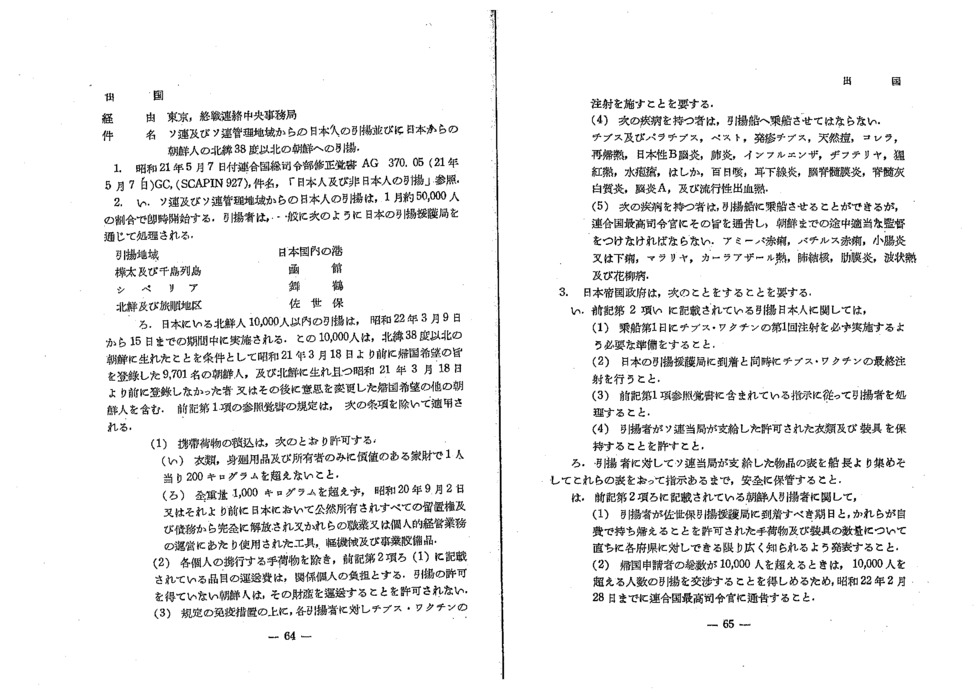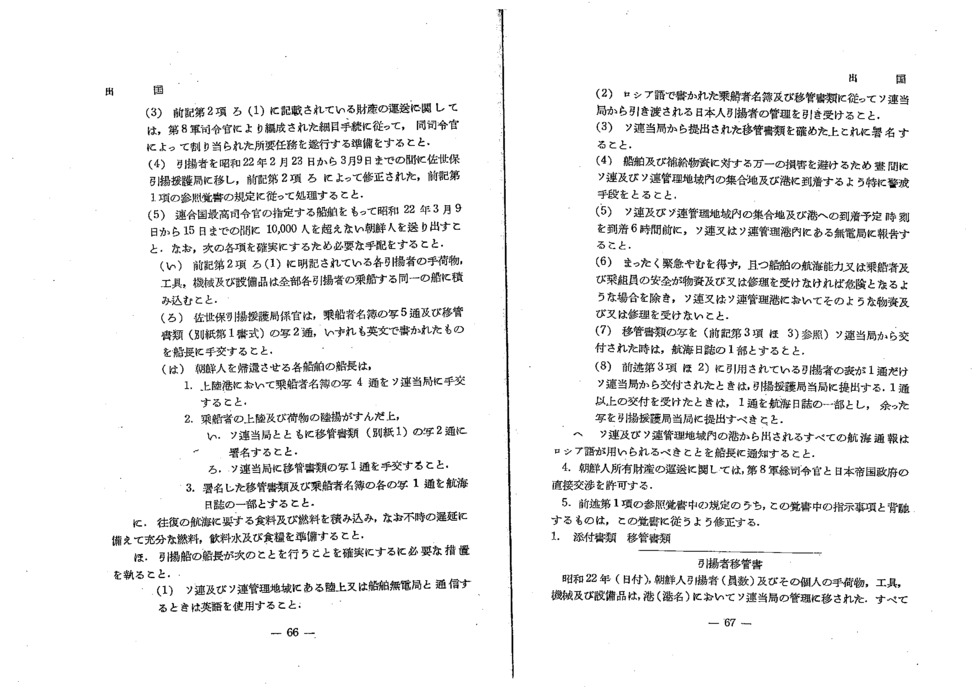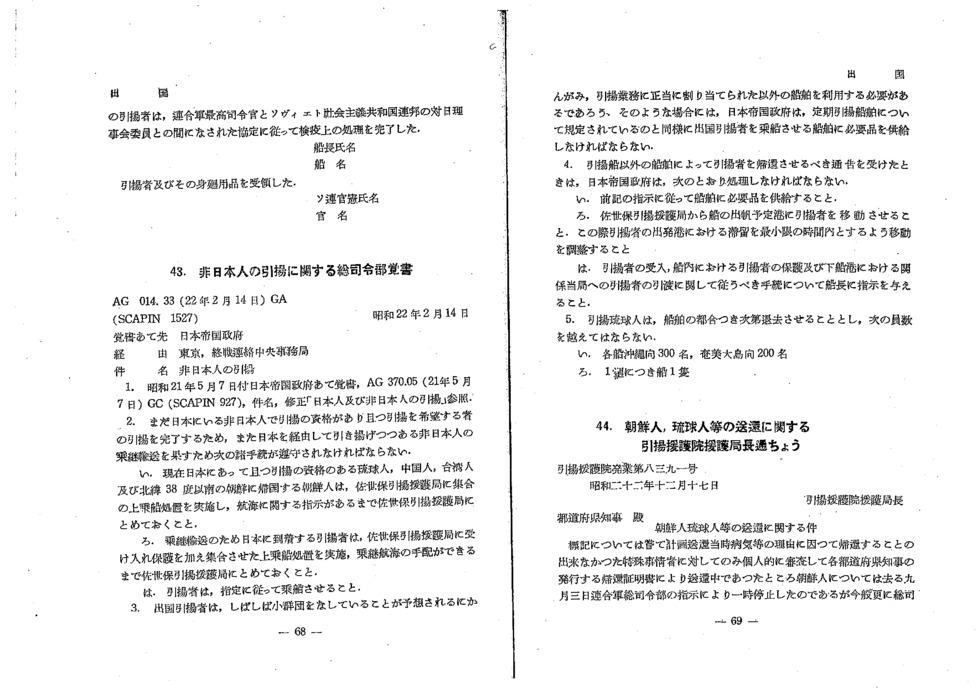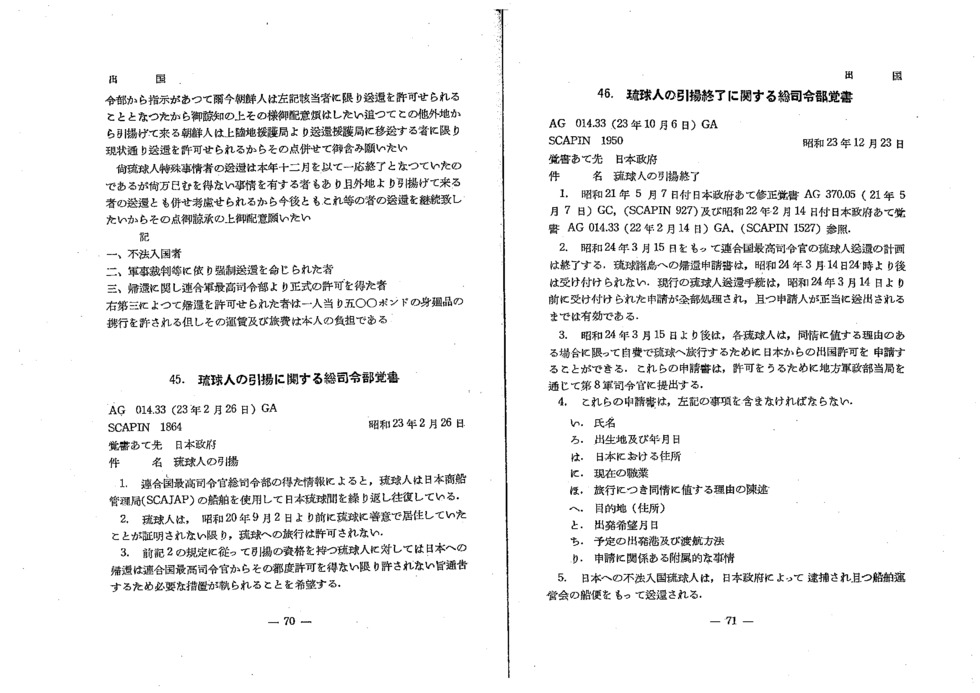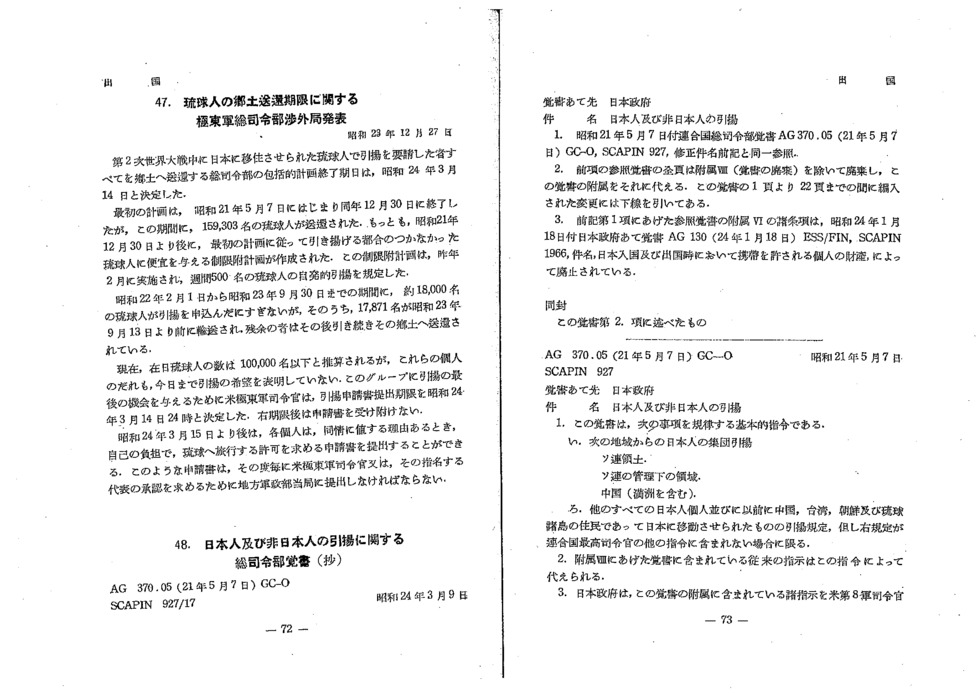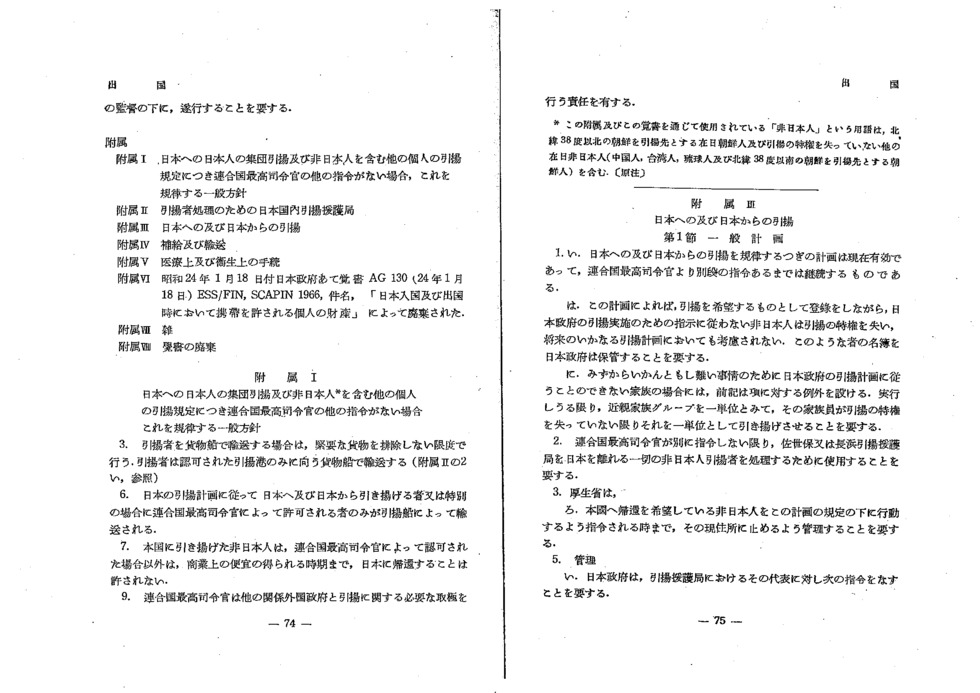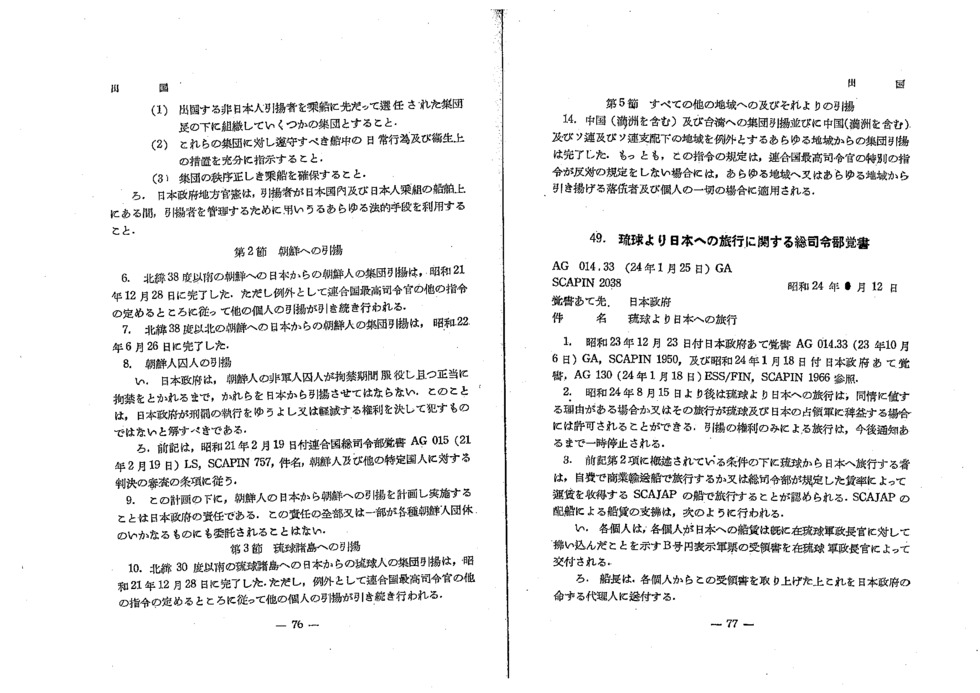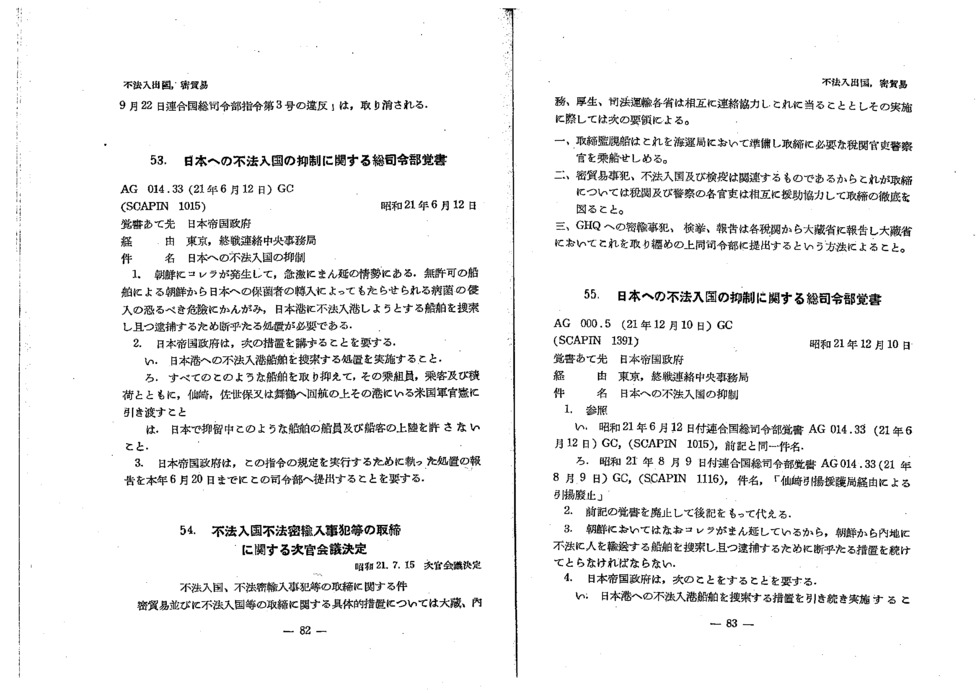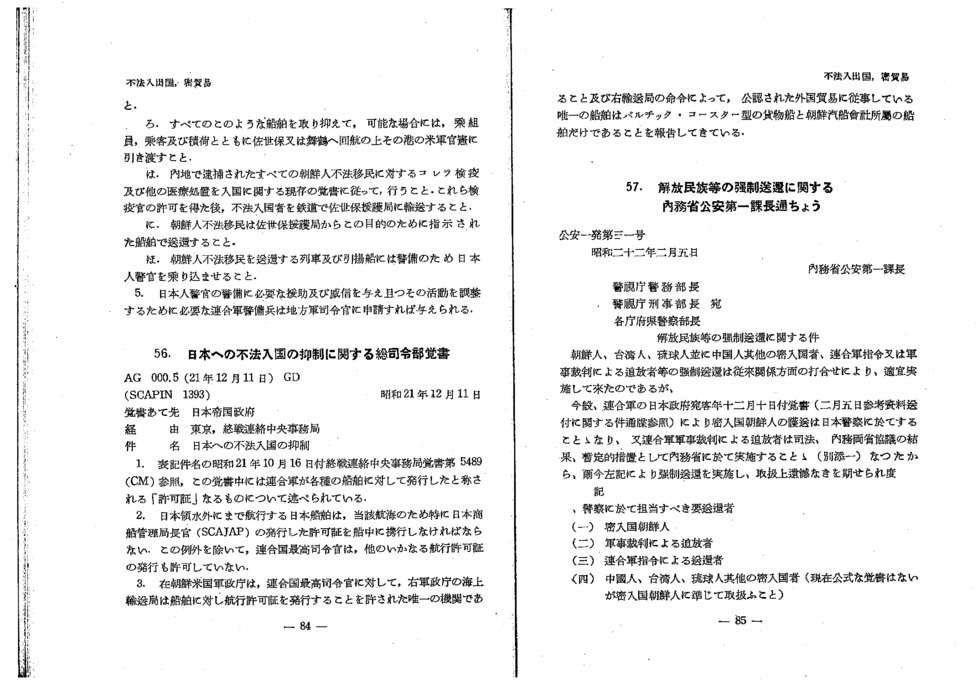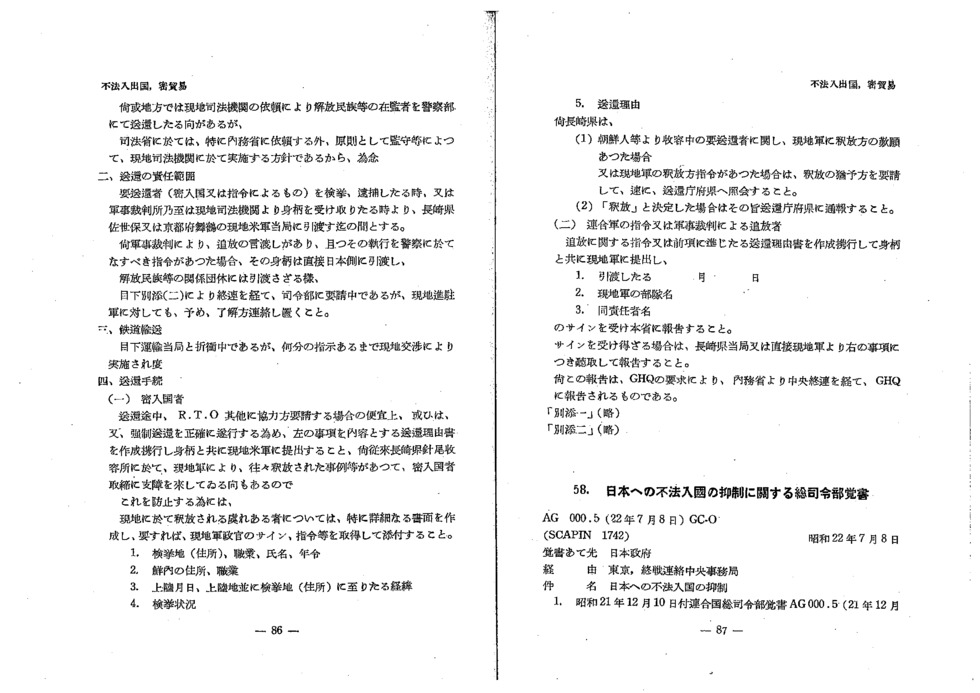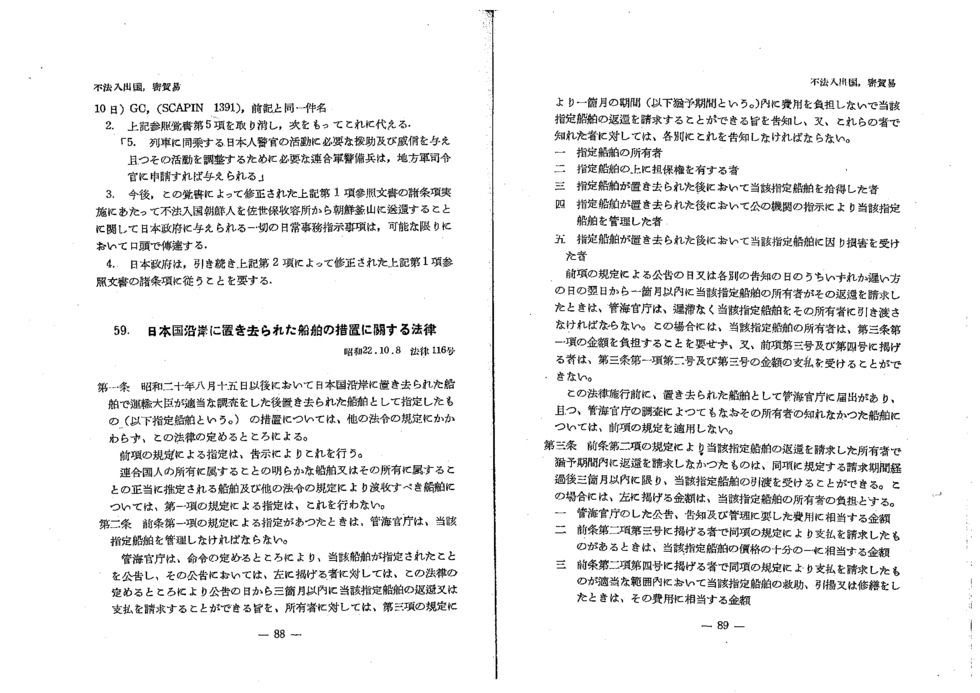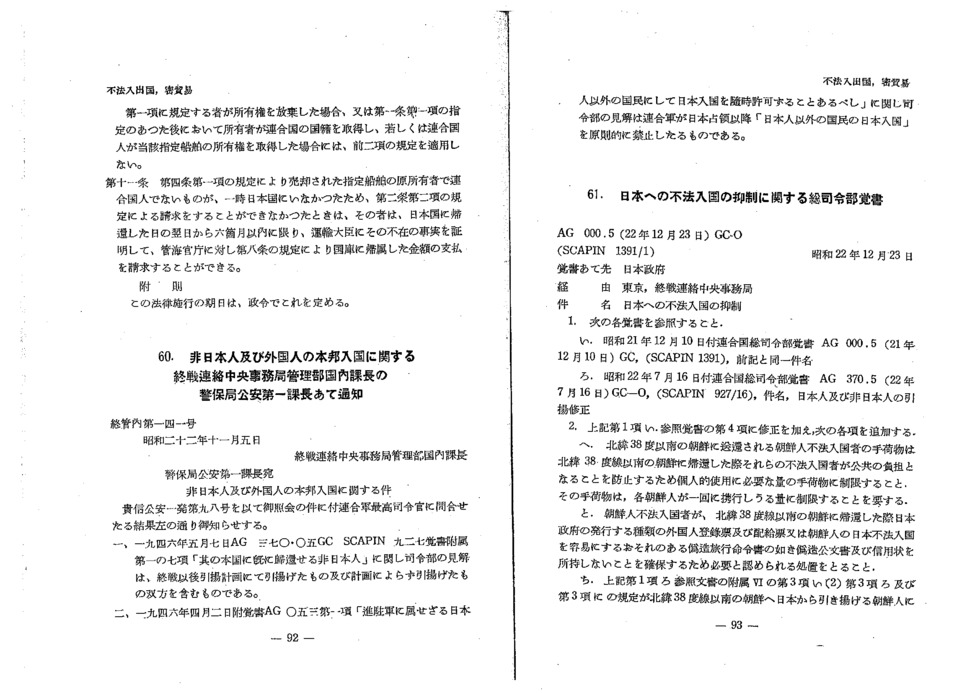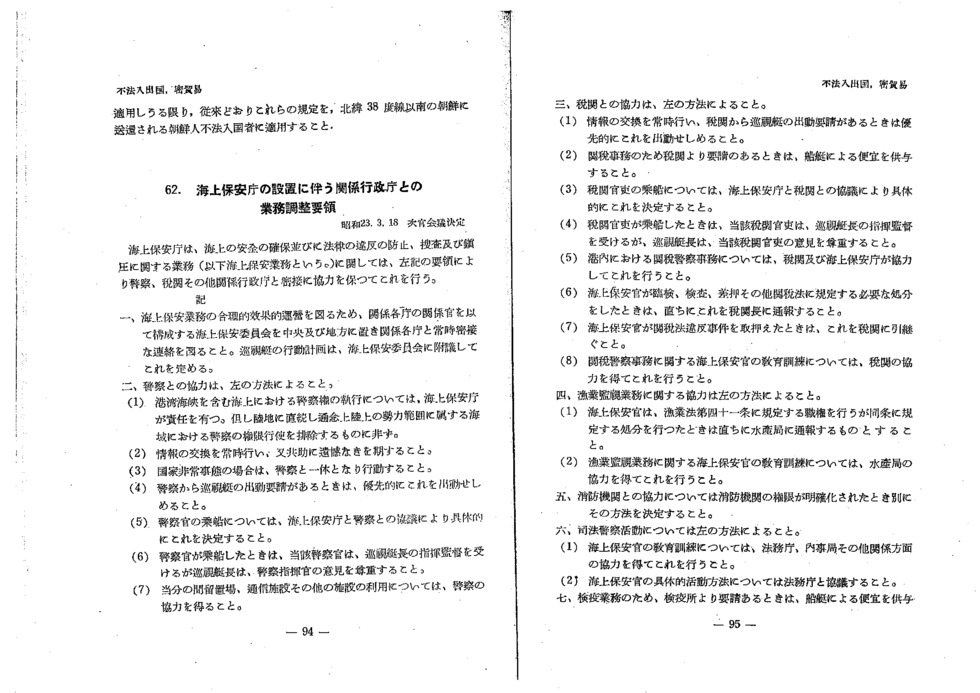Collection of Important Documents on Control of Koreans Residing in Japan 1945-1950
- Author
Page 1
Page 2
Page 3
Page 4
Page 5
Page 6
Page 7
Page 8
Page 9
Page 10
Page 11
Page 12
Page 13
Page 14
Page 15
Page 16
Page 17
Page 18
Page 19
Page 20
Page 21
Page 22
Page 23
Page 24
Page 25
Page 26
Collection of Important Documents on Control of Koreans Residing in Japan 1945-1950
(Ministry of Foreign Affairs, Political Affairs Bureau, Special Historical Materials Department; reissued by Kohokusha 1950)
- Announcement of the GHQ Public Relations Section regarding Status and Handling of Koreans
12 November 1946
Today, the GHQ official in charge announced that Koreans residing in Japan who refuse to return to their home country based on the GHQ repatriation plan are deemed to have Japanese nationality until such time as they are granted recognition as Korean nationals by a legitimately established Korean government.
The repatriation official said that any Korean who does not report to the Repatriation Reception Center when summoned for repatriation is deemed by that non-appearance to have refused, unless that is due to circumstances beyond the individual’s control. By that refusal, the individual forfeits the privilege of repatriation until such time as Japan and Korea resume normal commercial transportation.
He added that Koreans who refuse repatriation also lose the right to receive investigations by the occupation authorities regarding Japanese criminal court proceedings concerning them.
- 13. Announcement of the GHQ Civil Information and Education Section regarding Status and Handling of Koreans
12 November 1946
Today, the GHQ official in charge warned that Koreans residing in Japan who refuse to return to their home country based on the Allied Powers GHQ repatriation plan are deemed to have Japanese nationality until such time as they are granted recognition as Korean nationals by a legitimately established Korean government.
The spokesperson said that any Korean who does not report to the Repatriation Reception Center when summoned for repatriation is deemed by that non-appearance to have refused, unless that is due to circumstances beyond the individual’s control. By that refusal, the individual forfeits the privilege of repatriation until such time as Japan and Korea resume normal commercial transportation.
He added that Koreans who refuse repatriation also lose the right to receive investigations by the occupation authorities regarding Japanese court proceedings concerning them. Based on the provisions of the Supreme Commander for the Allied Powers Directive issued in February, judgments handed down by Japanese criminal courts against Koreans and nationals of other countries formerly under Japanese control who provide appropriate proof regarding their intention to return to their home country are subject to investigation and other measures by the Supreme Commander for the Allied Powers and deputies appointed by him.
Such investigations by the Supreme Commander for the Allied Powers may result in the termination, disapproval, suspension, or reduction of punishment in light of extenuating circumstances, or partial or complete remission or commutation of the sentence. In no case will the judgment rendered by the Japanese court be made more severe.
- Announcement of the GHQ Public Relations Section regarding the Status and Handling of Koreans
20 November 1946
Misunderstandings regarding the status and handling of Koreans residing in Japan that have recently appeared in certain types of newspapers need to be clarified.
From the beginning of the occupation, pursuant to the policy decisions of the U.S. and subsequently the Allied Powers, it has been the policy of the occupation authorities to treat Koreans as liberated people and take all possible measures for their welfare. Measures were promptly implemented to release individuals who were detained for political reasons from prisons and to free persons who were engaged in de-facto slave labor. The repatriation plan was put forth and up through today over 919,000 Koreans were repatriated, not including over 14,000 who illegally re-entered Japan and were deported again. There are presently around 600,000 Koreans in Japan and of these about 75,000 are requesting repatriation. The Japanese authorities are receiving strict orders so that the Koreans will not be discriminated against in any way and the occupation authorities are ceaselessly striving to make certain that these orders are thoroughly enforced.
Koreans who are charged with committing a crime by the police authorities are granted additional protection through investigation of their legal cases by the occupation authorities. Like all other persons who engage in illegal black-market trading and other criminal activities, Koreans are, of course, prosecuted. Newspaper reports to the effect that this GHQ issued an order that Koreans remaining in Japan after 15 December 1946 must obtain Japanese citizenship are entirely inaccurate. The occupation authorities have no intention of interfering in any way with the basic rights of persons of any nationality concerning maintaining, renouncing, or choosing citizenship. This GHQ issued a memorandum to the Japanese Government on 16 October 1946 stating that the repatriation of Koreans residing in Japan who previously lived south of 38 degrees north latitude must be completed before 15 December 1946, except for those persons who have already refused to follow the repatriation plan. Koreans who refuse repatriation and choose to remain in this country make that choice fully aware that they must follow all appropriate local laws and regulations if they continue residing in Japan. Discriminatory treatment advantageous to Koreans residing in Japan that exempts Koreans from the obligation to observe appropriate local laws and regulations would create a type of extraterritoriality. This is not warranted from any perspective and violates the general policy of the Allied Powers in light of the actions of the governments of each of the Allied Powers over the past several years to abolish vestiges of extraterritoriality in other countries.
- Announcement of the GHQ Civil Information and Education Section regarding Criminal Trial Jurisdiction over Koreans and Repatriation of Koreans
26 March 1946
According to a GHQ spokesperson, Koreans in Japan, like nationals of neutral nations in Japan, are subject to Japanese law including criminal law. Koreans and nationals of other countries formerly under Japanese control who have indicated a desire to repatriate can appeal cases in which they received discriminatory treatment in Japanese criminal courts to the occupation authorities. Such appeals can only be made after all reasonable relief measures under Japanese law have been exhausted.
These legal facts and repatriation regulations were made clear at a recent meeting between GHQ officials and the leaders of various organizations of Koreans residing in Japan.
To make use of the last opportunity for repatriation at the expense of the Japanese government, Koreans had to register with the Japanese government by18 March. All Koreans were required to register, and upon registration they had to state their desire or non-desire for repatriation. After the registration has been completed, and this issue has been researched, the GHQ is expected to decide the procedures to achieve repatriation and then instruct the Imperial Japanese Government on the methods of how to implement that plan.
Accordingly, persons who desire repatriation are required to depart at the time instructed by the Japanese government. If they fail to fulfill any one of these three requirements, they forfeit the privilege of repatriation at the expense of the Japanese government. And such persons must wait until commercial transportation facilities become available.
The spokesperson pointed out that such regulations are necessary for the government of Japan to prepare and implement an effective repatriation plan.
Koreans who attended this meeting were asked to warn their countrymen that repatriation under the Japanese government repatriation plan is their only official and safe method.
Because there are no normal facilities for sending money from Japan to Korea, and because of the need to control the circulation of currency in Korea, the Korean repatriates can bring home no more than 1,000 yen. They can also bring home deposit passbooks and insurance policies issued in Japan or Korea, and checks, drafts, and certificates of deposit issued by banks in Japan. The residual assets owned by Korean repatriates can be left in Japan in any form desired by the owner, and those residual assets are protected by the freeze orders of the Supreme Commander for the Allied Powers. The transfers of all funds to Korea by repatriates will be addressed when normal bilateral financial facilities are established.
- SCAPIN-746: REGISTRATION OF KOREANS, CHINESE, RYUKYUANS AND FORMOSANS
AG 053 (17 Feb 46) GC
(SCAPIN 746)
17 February 1946
MEMORANDUM FOR: IMPERIAL JAPANESE GOVERNMENT.
THROUGH: Central Liaison Office, Tokyo.
SUBJECT: Registration of Koreans, Chinese, Ryukyuans and Formosans.
- The Imperial Japanese Government will register all Koreans, Chinese, Ryukyuans and Formosans resident in Japan by 18 March 1946.
- Registration will include:
- Name
- Age
- Sex
- Place of residence in native land.
- Place of residence in Japan.
- Statement of desire concerning repatriation.
- In the case of those desirous of repatriation, the destination in repatriate’s native land.
- Those registering as not desirous of repatriation forfeit their privilege of repatriation.
- Individuals having received notification to register and failing to do so at or prior to the appointed time will be considered as not desiring repatriation and will forfeit their privilege of repatriation.
- Upon completion of registration the Imperial Japanese Government will report the following information to this headquarters:
- The total number of Koreans, Chinese, Ryukyuans and Formosans resident in Japan.
- The number of each nationality desiring repatriation.
- The total of Koreans desiring repatriation will be sub-totaled to show:
- Total of those whose destination is northern Korea (that portion of Korea north of 38 degrees north latitude).
- Total of those whose destination is Korean south of 38 degrees north latitude.
- The total of Ryukyuans desiring repatriation will show the subtotal for each destination island.
- The total of Chinese desiring repatriation will be subtotaled to show the number destined for North, Central, and South China respectively.
- Prior to registration and again at the time of registration the Imperial Japanese Government will inform the Koreans, Chinese, Ryukyuans and Formosans that:
- They are to be registered for the purpose of determining their desire or non-desire for repatriation.
- Failure to register will be grounds for forfeiture of repatriation privileges.
- Those registering as desirous of repatriation will be required to undergo repatriation in accordance with instructions issued by the Japanese Government or forfeit their repatriation privileges.
- That those registering as desirous of remaining in Japan forfeit their repatriation privileges.
- SCAPIN-852: ENTRY AND REGISTRATION OF NON-JAPANESE NATIONALS IN JAPAN
AG 053 (2 April 46) GA
(SCAPIN 852)
2 April 1946
MEMORANDUM FOR: IMPERIAL JAPANESE GOVERNMENT.
THROUGH: Central Liaison Office, Tokyo.
SUBJECT: Entry and Registration of Non-Japanese Nationals in Japan.
- From time to time non-Japanese nationals, not part of the Occupation Forces, will be granted permission to enter Japan. These persons will reside in Japan on a semi-permanent basis. Absence of Japanese consuls abroad and consequent impossibility of obtaining visas, necessitates the establishment of a procedure for legal entry and residence.
- It is desired that the Imperial Japanese Government take action to implement its part in the following procedure.
- This headquarters will notify persons approved for entry of such approval, informing them that visa requirements are waived, but that they will report for registration to the Japanese Ministry of Home Affairs upon arrival in Japan.
- The Imperial Japanese Government will be furnished the names of persons approved as described in a above.
- When such persons report to the Ministry of Home Affairs the Imperial Japanese Government will register them and furnish them with identification and such documents as are necessary to legalize their residence in Japan.
- SCAPIN-912-A: CONTROL OF FORMOSANS AND KOREANS AND USING RAILWAYS
AG 091 (4 Apr 46) GS
(SCAPIN 912-A)
4 April 1946
MEMORANDUM FOR: IMPERIAL JAPANESE GOVERNMENT
THROUGH: Central Liaison Office, Tokyo.
SUBJECT: Control of Formosans and Koreans and Using Railways.
- Reference is made to C.L.O. memorandum No. 538/13, dated 4 February 1946.
- The Japanese Government has full authority to control Formosans and Koreans using Japanese railways. This authority is subject only to those restrictions defined in the Supreme Commander’s Memoranda SCAPIN 756 and SCAPIN 757 file AG 015 (19 Feb 46) LS, subject: “Exercise of Criminal Jurisdiction” and “Review of Sentences Imposed upon Koreans and Certain Other Nationals”, respectively.
- It is the responsibility of the Japanese Government to exercise its full authority and to insure that peace and order are maintained on the Japanese railways.
- The request of the Japanese Government for an increase in the number of U.S. guards in railway stations is not favorably considered.
- SCAPIN-111-A: MISCONDUCTS COMMITTED BY KOREANS
AG 250.1 (30 Apr 46) GS
(SCAPIN 1111-A)
30 April 1946
MEMORANDUM FOR: IMPERIAL JAPANESE GOVERNMENT
THROUGH: Central Liaison Office, Tokyo.
SUBJECT: Misconducts committed by Koreans.
- Reference is made to C.L.O. Memorandum No. 1186(1.3), dated 13 March 1946.
- The Japanese Government has full authority to control Koreans who commit acts of violence as enumerated. This authority is stated in Memorandum for Imperial Japanese Government dated 4 April 1946, file AG 091 (4 Apr 46) GS, (SCAPIN 912-A), Subject: “Control of Formosans and Koreans Using Railways,” applies to crimes of violence as related in your C.L.O. No. 1186(1.3).
- Revolvers, Japanese swords, or other weapons taken from Koreans or others committing acts of violence will be delivered to an authorized representative of the Commanding General, Eighth Army.
- SCAPIN-927: REPATRIATION (Excepts)
AG 370.05 (7 May 46) GC
(SCAPIN 927)
7 May 1946
MEMORANDUM FOR: IMPERIAL JAPANESE GOVERNMENT.
THROUGH: Central Liaison Office, Tokyo
SUBJECT: Repatriation
- This memorandum is the basic directive governing repatriation of:
- Japanese nationals from areas under the military control of:
Commander-in-Chief, United States Army Forces, Pacific.
Commander-in-Chief, Pacific Ocean Areas.
Generalissimo, Chinese Armies.
Supreme Allied Commander, Southeast Asia Command.
General Officer Commanding, Australian Military Forces.
Commander-in-Chief, Soviet Forces in the Far East (when appropriate agreements have been consummated).
- Displaced persons in Japan formerly domiciled in China, Formosa, Korea and the Ryukyus.
- Previous instructions, as contained in the memorandums and radios listed in Annex VIII, are superseded by this directive.
- In the future, in so far as practicable, all general directives concerning repatriation to and from the areas listed in paragraph 1 above, will be issued to the Imperial Japanese Government in the form of additions or amendments to this memorandum.
- The Imperial Japanese Government will carry out the instructions as contained in annexes to this memorandum, under the supervision of the Commanding General, Eighth United States Army.
Annexes
Annex I General Policies Governing Repatriation of Japanese Nationals in Formerly Japanese Occupied Territory, and Non-Japanese from Japan.
Annex II Reception Centers in Japan for Processing Repatriates
Annex III Repatriation to and from Japan
Annex IV Supply and Transportation
Annex V Medical and Sanitary Procedures
Annex VI Currency, Securities, and Other Documents and Possessions
Annex VII Miscellaneous
Annex VIII Rescissions
ANNEX I
GENERAL POLICIES GOVERNING REPATRIATION OF JAPANESE NATIONALS IN FORMERLY JAPANESE OCCUPIED TERRITORY, AND NON-JAPANESE*, FROM JAPAN
The following policies will govern repatriation of Japanese nationals in formerly Japanese occupied territory, and non-Japanese from Japan. *
- Only personnel being repatriated to and from Japan under the Japanese repatriation program or such others as may be authorized in special cases by the Supreme Commander for the Allied Powers will be transported on repatriation vessels.
- Non-Japanese nationals who have been repatriated to their homelands will not be permitted to return to Japan until such time as commercial facilities are available, except as authorized by the Supreme Commander for the Allied Powers.
*The term “non-Japanese” as used in this annex and throughout this memorandum includes only Chinese, Formosans, Koreans, and Ryukyuans.
ANNEX III
REPATRIATION TO AND FROM JAPAN
SECTION I – GENERAL PLAN
- Under this plan non-Japanese nationals who, having registered as being desirous of repatriation, refuse to comply with the plan of the Imperial Japanese Government for movement to reception centers, forfeit their privilege to repatriation and will not be considered in any future repatriation plans. A list of such persons by name will be maintained by the Japanese government.
SECTION II – REPATRIATION OF KOREANS
- The following plan governs the repatriation of Korean nationals.
- Shipping
- Japan – Korea Shuttles.
Short range Japanese repatriation shipping in the Japan – Korea shuttles is assigned so as to make available the following number of spaces daily:
Initially By 5 May 1946
Hakata 1,500 3,000
Senzaki 500 1,000
- Japan – Korea – China shuttles
Certain Japanese shipping, shuttling between Shanghai and Hakata, may be loaded with Koreans at Hakata for debarkation at Pusan.
- Processing of Koreans through Japanese ports.
- The repatriation of Koreans now in Japan who were formerly resident in Korea south of 38˚ north latitude will be completed on or before 30 September 1946.
- Koreans will be outloaded to Pusan from the following ports at the daily rates indicated:
Initially By 5 May 1946
Hakata 1,500 3,000
Senzaki 500 1,000
TOTAL 2,000 4,000
Initial daily rates indicated above will be progressively increased to insure that the prescribed rates are reached by 5 May 1946. Thereafter the prescribed rates will be maintained until all Koreans desirous of repatriation are either cleared from Japan or have forfeited their privilege to repatriation. Sufficient Koreans will be backlogged in these reception centers to insure the above.
- Repatriation to Korea north of 38 degrees north latitude.
Repatriation to northern Korea will be held in abeyance pending consummation of appropriate agreements. Koreans destined for northern Korea will be held in Japan until such time as they can be repatriated to northern Korea.
- Repatriation of Korean prisoners.
- The Imperial Japanese Government will not repatriate Korean civil prisoners in Japan until they have served their term of imprisonment and are duly released from confinement. This shall not be construed as in any way infringing upon the prerogative of the Imperial Japanese Government to remit or mitigate sentences.
- The above is subject to the provisions of memorandum, from the Supreme Commander for the Allied Powers, file AG 015 (19 Feb 46) LS, (SCAPIN-757), dated 19 February 1946, subject: “Review of Sentences Imposed upon Koreans and Certain Other Nationals.”
SECTION III – REPATRIATION OF FORMOSANS
- The following plan covers the repatriation of Formosan Nationals,
- Shipping
Empty spaces on certain vessels bound for the Philippine Islands, or areas under the control of the Supreme Allied Commander, Southeast Asia Command, or Australian Military Forces, will be filled with Formosans who will be debarked in Formosa (See paragraph 4b above).
- Processing of Formosans through Japanese Ports.
Formosans desiring repatriation from Japan will be assembled at the Kure area reception center during the week 5-11 May 1946 for evacuation on Japanese-manned shipping.
SECTION IV – REPATRIATION TO AND FROM THE RYUKYUS
- The following plan governs the repatriation of Ryukyuans from Japan to their home islands, and of Japanese from the Ryukyus to Japan.
- Repatriation of Ryukyuans from Japan.
- All repatriation to the Ryukyus is suspended until further notice.
- The Imperial Japanese Government will provide adequate food, shelter, medical care, bedding and clothing for destitute Ryukyuan refugees.
ANNEX VI
CURRENCY, SECURITIES, AND OTHER DOCUMENTS AND POSSESSIONS
- The Ministry of Public Welfare will carry out the following procedures in processing Japanese being repatriated to Japan, and Chinese, Formosans, Koreans, and Ryukyuans to their respective homelands.
- In processing Koreans, Chinese, or Formosan nationals, or Ryukyuans being repatriated from Japan to their respective homelands, the Imperial Japanese Government will:
- Permit them to take with them yen currency in an amount not to exceed ¥1,000 per person.
- Chinese, Formosans and Ryukyuans will take Bank of Japan currency.
- The Imperial Japanese Government will exchange Bank of Chosen currency for Bank of Japan currency, for Korean nationals, on a one to one basis.
- Permit Koreans and Chinese to take with them in addition to currency:
- Postal savings pass books and bank pass books issued by financial institutions in Japan and in the country to which they are being repatriated.
- Insurance policies issued in Japan and in the country to which they are being repatriated.
- Checks, drafts and certificates deposit drawn on and issued by financial institutions in Japan and payable in Japan
- Permit them to carry with them their clothing and personnel possessions of value only to the owner. These effects will be limited in weight to 250 pounds per person. The Imperial Japanese Government will take the necessary steps to handle this additional baggage without delaying the repatriation program.
- (1) Take up against individual receipt:
- All other currency and yen currency in excess of the amount set forth in paragraph 3a above. All Bank of Japan currency carried by Korean repatriates will be collected and individual receipts will be issued for all that over and above the amount taken in exchange for Bank of Chosen currency (see paragraph 3a(2) above, and memorandum from the Supreme Commander for the Allied Powers, file AG 091.31 (30 Mar 46) ESS/FI, (SCAPIN-854-A), dated 30 March 1946, subject: “Conversion of Currency for Korean Repatriates”).
- Gold, silver, or platinum bullion or alloy thereof in bullion form.
- Checks, drafts, bills of exchange, securities, promissory notes, payment instructions, transfer orders, or other financial instruments, except as specified in paragraph 3b above.
- Powers of attorney, proxies, or other authorization or instructions to effect financial or property transactions within or outside Japan.
- Any other evidence of indebtedness or evidence of ownership of property not specifically enumerated above, except as specified in paragraph 3b above.
- Art objects and personal property of value to others beside the possessor, and personal possessions in excess of limits prescribed in paragraph 3c above.
- Hold those items taken up against individual receipt in safe custody pending further
direction from the Supreme Commander for the Allied Powers.
NOTE:
Regarding the blank space in Annex III, Section I, 1., according to the original text of SCAPIN 927 there are originally two paragraphs which read, “The following plan governing the repatriation to and from Japan, now in effect, will continue until otherwise directed by the Supreme Commander for the Allied Powers,” and “The entire plan resolves around the use of reception centers and the flow of persons to be repatriated though these centers in the numbers that can be accommodated by the available shipping and rail transportation.” Here, these are left blank as in the original historical materials.
- SCAPIN-1113: REPATRIATION TO AND FROM KOREA
AG 014.33 (8 Aug 46) GC
(SCAPIN-1113) 8 August 1946
MEMORANDUM FOR: IMPERIAL JAPANESE GOVERNMENT.
THROUGH: Central Liaison Office, Tokyo.
SUBJECT: Repatriation to and from Korea.
- Reference is made to:
- Memorandum from the Supreme Commander for the Allied Powers, file AG 370.05 (7 May 46) GC, (SCAPIN-927), dated 7 May 1946, subject: “Repatriation”, as amended.
- Memorandum from the Supreme Commander for the Allied Powers, file AG 014.33 (27 Jun 46) GC, (SCAPIN-1039), dated 27 June 1946, subject: “Repatriation to Korea.”
- Memorandum from the Supreme Commander for Allied Powers, file AG 014.33 (27 Jul 46) GC, (SCAPIN-1088), dated 27 July 1945, subject: “Repatriation to Korea”
- All instructions contained in the memorandums referred to above, which are in conflict with this memorandum, are superseded herewith.
- Effective 10 August 1946, the following plan governs the repatriation of Koreans in Japan, who desire to return to their homes in Korea south of 38˚ north latitude.
- The repatriation of Koreans in Japan, who were formerly resident in Korea south of 38˚ north latitude, will be completed on or before 15 November 1946, except as noted in paragraph 1d, Annex III to reference paragraph 1a above.
- Repatriation shipping is assigned to lift 4,000 Koreans per day from Hakata, Japan, to Pusan, Korea. These ships will be returned empty to Japan.
- Shipping will be scheduled as necessary to lift Japanese from Korea to Sasebo.
- The Imperial Japanese Government will:
- Backlog sufficient Koreans in the Hakata Reception Center to insure that repatriates are available at the rate prescribed in paragraph 5a above.
- Receive and process Japanese repatriates arriving in Japan from Korea as prescribed in reference paragraph 1a above.
- Process all ships, arriving in Sasebo from Korea, as prescribed in paragraph 3b (2), Annex V to reference paragraph 1a above.
- Continue to comply with the provisions of paragraph 1c, Annex III to reference paragraph 1a above.
- Submit a report to the Supreme Commander for the Allied Powers by 30 November 1946 showing:
- Names of Koreans, listed by family, who were not repatriated on or before 15 November 1946, but who have not forfeited their privilege of repatriation, as outlined in paragraph 1d, Annex III to reference paragraph 1a above.
- Approximate date each family, referred to in paragraph 6e (1) above, will be able to move to Hakata Reception Center. In any case, delay in repatriation is not authorized beyond 31 December 1946.
- SCAPIN-1273: REPATRIATION TO KOREA
AG 014.33 (16 Oct 46) GC
(SCAPIN-1273) 16 October 1946
MEMORANDUM FOR: IMPERIAL JAPANESE GOVERNMENT.
THROUGH: Central Liaison Office, Tokyo.
SUBJECT: Repatriation to Korea.
- Reference is made to:
- Memorandum from the Supreme Commander for the Allied Powers, file AG 370.05 (7 May 46) GC, (SCAPIN-927), dated 7 May 1946, subject: “Repatriation”, as amended.
- Memorandum from the Supreme Commander for the Allied Powers, file AG 014.33 (8 Aug 46) GC, (SCAPIN-1113), dated 8 August 1946, subject: “Repatriation to and from Korea.”
- Memorandum from the Supreme Commander for Allied Powers, file AG 014.33 (26 Sept 46) GC, (SCAPIN-1230), dated 26 September 1946, subject as above.
- The provisions of references paragraph 1c above are rescinded. Effective 17 October 1946 repatriation of Koreans in Japan, who desire to return to their homes in Korea south of 38˚ north latitude, is resumed as prescribed in references paragraph 1a and 1b above.
- The repatriation of Koreans in Japan, who were formerly residents in Korea south of 38˚ north latitude, will be completed on or before 15 December 1946, except as noted in paragraph 1d, Annex III to references paragraph 1a above. Paragraph 9a, Annex III to references paragraph 1a above, and paragraphs 4 and 6e of reference paragraph 1b above are amended hereby.
- The Koan Maru is designated to lift illegal Korean immigrants, who have completed their cholera quarantine period and are now being held at Sasebo Reception Center, from Japan to Korea.
- The Imperial Japanese Government will:
- Resume repatriation of Koreans through the Hakata Reception Center.
- Place illegal Korean immigrants aboard Koan Maru.
- Furnish the necessary Japanese policemen as guards on the Koan Maru as directed by the Commanding General, Eighth US Army or his representative.
- SCAPIN-1414: TERMINATION OF MASS REREPATRIATION FROM JAPAN
AG 014.33 (19 DEC 46) GC
(SCAPIN-1414) 19 December 1946
MEMORANDUM FOR: IMPERIAL JAPANESE GOVERNMENT.
THROUGH: Central Liaison Office, Tokyo.
SUBJECT: Termination of Mass Repatriation from Japan.
- Reference is made to:
- Memorandum for the Imperial Japanese Government, file AG 370.05 (7 May 46) GC, (SCAPIN-927), dated 7 May 1946, subject, “Repatriation.”.
- Memorandum for the Imperial Japanese Government, file AG 014.33 (24 Jul 46) GC, (SCAPIN-1081), dated 24 July 1946, subject, “Repatriation of Ryukyuans Now in Japan,” as amended.
- Memorandum for the Imperial Japanese Government, file AG 014.33 (15 Oct 46) GC, (SCAPIN-1273), dated 16 October 1946, subject, “Repatriation to Korea.”
- Memorandum for the Imperial Japanese Government, file AG 014.33 (16 Dec 46) GC, (SCAPIN-1407), dated 16 December 1946, subject as above.
- Mass repatriation of Koreans from Japan to areas in Korea, south of 38˚ north latitude, under provisions of reference 1c above was completed 15 December 1946.
- Completion date for mass repatriation of Ryukyuans from Japan to areas in the Ryukyu Islands south of 30˚ north latitude under provisions of reference 1b above is announced as 26 December 1946.
- The Imperial Japanese Government will:
- (1) Accept and process at Hakata Reception Center until 27 December 1946 repatriates destined Korea, south of 38˚ north latitude, who are eligible for repatriation under the provisions of reference 1c above but who arrive at Hakata Reception Center after 15 December 1946.
(2) Outload in shipping to be furnished by the Supreme Commander for the Allied Powers all eligible Korean repatriates from Hakata Reception Center not later than 28 December 1946.
- (1) Accept and process at reception centers located at Nagoya, Kure, Kagoshima and Sasebo until 22 December 1946 repatriates destined the Ryukyu Islands who are eligible for repatriation under the provisions of reference 1b above.
(2) Outload in shipping to be furnished by the Supreme Commander for the Allied Powers all eligible Ryukyuan repatriates from the Nagoya, Kure, Kagoshima and Sasebo Reception Centers not later than 28 December 1946.
- SCAPIN-1421: REPATRIATION OF JAPANESE NATIONALS FROM SOVIET AND SOVIET-CONTROLLED TERRITORIES AND OF KOREANS FROM JAPAN TO KOREA NORTH OF 38 DEGREES NORTH LATITUDE
AG 014.33 (26 Dec 46) GC
(SCAPIN 1421) 26 December 1946
MEMORANDUM FOR: IMPERIAL JAPANESE GOVERNMENT.
THROUGH: Central Liaison Office, Tokyo.
SUBJECT: Repatriation of Japanese Nationals from Soviet and Soviet-Controlled Territories, and of Koreans from Japan to Korea North of 38˚ North Latitude
- Reference is made to Memorandum from the Supreme Commander for the Allied Powers, file AG 370.05 (7 May 46) GC, (SCAPIN 927), dated 7 May 1946, subject: Repatriation, as amended.
- Repatriation of Japanese Nationals from Soviet and Soviet-controlled territories will be accomplished at a rate of approximately 50,000 persons per month effective at once. Repatriates will be processed through reception centers in Japan in general as follows:
Area from which repatriated Port in Japan
Karafuto and Kurile Islands Hakodate
Siberia Maizuru
North Korea and Port Arthur Area Sasebo
- The repatriation of not to exceed 10,000 Northern Koreans in Japan, will be accomplished during the period of 9-15 March 1947 inclusive. This 10,000 will include those 9,701 Koreans who registered prior to 18 March 1946 as being desirous of repatriation provided they were born in Korea north of 38˚ North Latitude, and such other Koreans desirous of repatriation who were born in North Korea and did not register prior to 18 March 1946 or have changed their minds since that date. Provisions of reference paragraph 1 above will govern except as follows:
- Accompanied baggage shipment is authorized as follows:
- Clothing, personal possessions and household effects of value only to the owner, not to exceed 200kg. per individual.
- Tools, light machinery and business equipment, not exceeding 1,000 kg. in weight, owned outright by then or prior to 2 September 1945, free and clear of all liens and encumbrances, and used in the operation of their trades or individually operated businesses in Japan.
- Shipment of the items mentioned in paragraph 2b(1) above, except personal baggage carried by the individual, will be at the expense of the individual concerned. Koreans not authorized for repatriation are not authorized to have property shipped.
- In addition to the prescribed immunizations, typhoid vaccine will be administered to each repatriate.
- Persons with the following diseases will not be placed aboard repatriation ships: typhoid and paratyphoid fevers, plague, typhus, smallpox, cholera, relapsing fever, Japanese “B” encephalitis, pneumonia, influenza, diphtheria, scarlet fever, chicken pox, measles, pertussis, mumps, cerebrospinal meningitis, poliomyelitis, encephalitic “A”, and epidemic hemorrhagic fever.
- Persons with the following diseases may be placed aboard repatriation ships, provided the Supreme Commander for the Allied Powers is notified and proper surveillance is maintained enroute to Korea: amebic dysentery, bacillary dysentery, enteritis or diarrhea, malaria, kala azar, tuberculosis, pleurisy, undulant fever and venereal disease.
- The Imperial Japanese Government will:
- Concerning Japanese repatriates mentioned in paragraph 2a above:
- Make the necessary arrangements to insure that the initial dose of typhus vaccine is administered the first day they are aboard ship.
- Administer the final dose of typhus vaccine upon their arrival at reception centers in Japan.
- Process them in accordance with the instructions contained in reference paragraph 1 above.
- Allow them to retain authorized clothing and equipment issued by Soviet authorities.
- Collect from the ships’ masters the lists of articles supplied by the Soviet authorities to the repatriates, and hold such lists in safe keeping pending further instructions.
- Concerning Korean repatriates mentioned in paragraph 2b above:
- Give maximum publicity at once to all prefectures concerning the date they are to be in the Sasebo Reception Center, and the amount of baggage and equipment they are authorized to take with them at their own expense.
- Notify the Supreme Commander for the Allied Powers by 28 February 1947 if the total number who make application for repatriation exceed 10,000 persons, in order that negotiations for repatriation of those exceeding 10,000 may be made.
- In accordance with detailed procedure to be formulated by the Commanding General, Eighth Army, be prepared to perform necessary functions allocated by the Commanding General, Eighth Army in connection with the shipment of property mentioned in paragraph 2b(1) above.
- Move them to the Sasebo Reception Center during the period 23 February to 9 March 1947 and process them in accordance with the provisions of reference paragraph 1 above, as amended by paragraph 2b above.
- Outload not to exceed 10,000 Koreans during the period 9-15 March 1947 inclusive on shipping designated by the Supreme Commander for the Allied Powers. In addition, make the necessary arrangements to insure that:
- All of each repatriate’s baggage, tools, machinery and equipment, as specified in paragraph 2b(1) above, are placed on the same ship on which the individual is being repatriated.
- The Sasebo Reception Center officials furnish the ships’ masters with five (5) copies of the passenger list, and two (2) copies of a document of transfer (form attached as inclosure 1 hereto), both written in the English language.
- The master of each ship repatriating Koreans:
- Furnishes the Soviet authorities at the port of debarkation with four (4) copies of the passenger list.
- Upon debarkation of the passengers and their baggage:
- Sign, with the Soviet authorities, the two (2) copies of documents of transfer (inclosure 1).
- Furnish the Soviet authorities with one (1) copy of the document of transfer.
- Make one (1) copy of each of the signed document of transfer and of the passenger list part of the ship’s log.
- Provision and fuel ships for the round trip, plus enough fuel, water and food to take care of unforeseen delays.
- Take the necessary measures to insure that the masters of repatriation ships:
- Use the English language when communicating with shore or ship stations in Soviet or Soviet-controlled areas.
- Accept custody of Japanese repatriates, which will be transferred by the Soviet authorities to them according to passenger lists and transfer documents written in the Russian language.
- After verification, sign the transfer documents presented by the Soviet authorities.
- Take special precautions, to include arrival at rendezvous points and ports in Soviet and Soviet-controlled areas during daylight hours, to avoid possible damage to ships and supplies.
- Report to stations in Soviet or Soviet-controlled ports the estimated time of arrival at rendezvous points and ports in Soviet and Soviet-controlled areas six (6) hours prior to arrival thereat.
- Do not accept supplies and/or repairs in Soviet or Soviet-controlled ports, except in dire emergency and unless the seaworthiness of the ships or the safety of the passengers and the crews is endangered by failure to accept such supplies and/or repairs.
- Make a copy of the document of transfer, referred to in paragraph 3e(3) above, when furnished by the Soviet authorities, part of the ship’s log.
- Turn over the list of repatriates, referred to in paragraph 3e(2) above, to the reception center authorities, if only one (1) copy is furnished by the Soviet authorities. If more than one (1) copy is furnished, one (1) copy will be made part of the ship’s log and extra copies will be turned over to reception center authorities.
- Inform the ships’ masters that the Russian language will be used in all navigation messages issued from ports in Soviet and Soviet-controlled areas.
- Direct communication is authorized the Imperial Japanese Government in connection with the shipment of Korean-owned property with the Commanding General, Eighth Army.
- Provisions of reference paragraph 1 above, which are in conflict with instructions contained herein, are amended accordingly.
1 Incl
Transfer Document
TRANSFER OF REPATRIATES
On ____________ (Date) 1947, ___________ (Number) Korean repatriates and their personal baggage, tools, machinery and equipment were transferred to the custody of the Soviet authorities at the port of ___________ (Name). All repatriates have been medically processed in accordance with the agreements reached between the Supreme Commander of the Allied Powers and the member of the Allied Council for Japan from the Union of Soviet Socialist Republics.
____________________________________
(Ship master’s name)
_____________________________________
(Name of ship)
Repatriates and their personal belongings were received by:
__________________________________
(Soviet authority’s name)
__________________________________
(Official designation)
- SCAPIN-1527: REPATRIATION OF NON-JAPANESE
AG 014.33 (14 Feb 47) GA
(SCAPIN 1527) 14 February 1947
MEMORANDUM FOR: IMPERIAL JAPANESE GOVERNMENT.
THROUGH: Central Liaison Office
SUBJECT: Repatriation of Non-Japanese
- Reference is made to Memorandum for the Imperial Japanese Government, file AG 370.05 (7 May 46) GC (SCAPIN 927), dated 7 May 1946, subject, “Repatriation”, as amended.
- In order to complete the repatriation of non-Japanese nationals still in Japan, who are eligible for and desirous of repatriation, and to effect the onward shipment of non-Japanese nationals who are being repatriated via Japan, the following procedures will be followed:
- Ryukyuans, Chinese, Formosans and Koreans destined for Korea south of 38˚ North Latitude, now in Japan and who are eligible for repatriation, will be assembled at Sasebo Reception Center, processed for shipment, and held in the Sasebo Reception Center pending shipping instructions.
- Repatriates arriving Japan for onward shipment will be received, cared for, assembled at Sasebo Reception Center, processed for shipment, and held in Sasebo Reception Center pending arrangements for onward shipping.
- Repatriates will be embarked on shipping as designated.
- In view of the fact that outgoing repatriates will often be in small groups, it will be necessary to utilize shipping other than that regularly assigned to repatriation service. In such cases the Imperial Japanese Government will provision the ships to accommodate the repatriates to be embarked in the same manner as prescribed for regular repatriation shipping.
- Upon notification that repatriates are to be outloaded on other than repatriation shipping, the Imperial Japanese Government will:
- Provision the ships in accordance with above instructions.
- Move the repatriates from Sasebo Reception Center to the port from which the ship is scheduled to depart, coordinating the movement so that repatriates will be in the port of departure a minimum length of time.
- Instruct the masters of the ships in the procedures to be followed in receiving repatriates, care of repatriates while aboard ship, and delivery to appropriate authorities at the port of debarkation.
- Ryukyuan repatriates will be outloaded as shipping is available and not to exceed.
- 300 for Okinawa and 300 for Amami O’Shima aboard each ship.
- One ship per week.
- SCAPIN-927/17: REPATRIATION (Excerpts)
AG 370.05 (7 May 46) GC-O
(SCAPIN 927/17) 9 March 1949
MEMORANDUM FOR: JAPANESE GOVERNMENT.
SUBJECT: Repatriation
- Reference is made to memorandum from the Supreme Commander for the Allied Powers, file AG 370.05 (7 May 46) GC-O, SCAPIN 927, dated 7 May 1946, subject as above, as amended.
- All pages of the reference in paragraph 1 above are rescinded with the exception of Annex VIII thereto (Rescissions), and the pages attached will be substituted therefor. Changes incorporated in the new pages, 1-22, have been underlined.
- The provisions of Annex VI, reference paragraph 1 above, have been rescinded by Memorandum for the Japanese Government, AG 130 (18 Jan 49) ESS/FIN, SCAPIN 1966, dated 18 January 1949, subject: Property Individuals are Authorized to Carry on Entering and Leaving Japan.
Incl
As indicated in par 2
AG 370.05 (7 May 46) GC-O
(SCAPIN 927)
7 May 1946
MEMORANDUM FOR: JAPANESE GOVERNMENT.
SUBJECT: Repatriation
- This memorandum is the basic directive governing:
- The mass repatriation of Japanese nationals from the following areas:
Territory of the Union of Soviet Socialist Republics, Territories under control of Union of Soviet Socialist Republics.
China (including Manchuria).
- The provisions for repatriation of all other individual Japanese nationals and displaced persons in Japan formerly domiciled in China, Formosa, Korea and the Ryukyus, insofar as these provisions are not covered by other directives of the Supreme Commander for the Allied Powers.
- Previous instructions, as contained in the memorandum listed in Annex VIII, are superseded by this directive.
- The Japanese Government will carry out the instructions as contained in annexes to this memorandum, under the supervision of the Commanding General, Eighth United States Army.
Annexes
Annex I General Policies Governing Mass Repatriation of Japanese Nationals to Japan and
Provisions for the Repatriation of Other Individuals, Including Non-Japanese, insofar as These Provisions are not Covered by Other Directives of the Supreme Commander for the Allied Powers
Annex II Reception Centers in Japan for Processing Repatriates
Annex III Repatriation to and from Japan
Annex IV Supply and Transportation
Annex V Medical and Sanitary Procedures
Annex VI Rescinded by Memorandum to the Japanese Government, AG 130 (18 Jan 49), ESS/FIN, SCAPIN-1966 dated 18th January 1949, subjects: Property Individuals are Authorized to Carry on Entering and Leaving Japan
Annex VII Miscellaneous
Annex VII Rescissions
ANNEX I
GENERAL POLICIES GOVERNING MASS REPATRIATION OF JAPANESE NATIONALS TO JAPAN AND PROVISOINS FOR THE REPATRIATION OF OTHER INDIVIDUALS, INCLUDING NON-JAPANESE*, INSOFAR AS THESE PROVISIONS ARE NOT COVERED BY OTHER DIRECTIVES OF THE SUPREME COMMANDER FOR THE ALLIED POWERS
- Personnel to be repatriated will not be transported on cargo vessels to the extent that the essential cargo is displaced. Repatriates will be transported on cargo vessels destined only for authorized repatriation ports (see paragraph 2a, Annex II).
- Only personnel being repatriated to and from Japan under the Japanese repatriation program or such others as may be authorized in special cases by the Supreme Commander for the Allied Powers will be transported on repatriation vessels.
- Non-Japanese nationals who have been repatriated to their homelands will not be permitted to return to Japan until such time as commercial facilities are available, except as authorized by the Supreme Commander for the Allied Powers.
- The Supreme Commander for the Allied Powers is responsible for making necessary arrangements concerning repatriation with other interested foreign governments.
*The term “non-Japanese” as used in this annex and throughout this memorandum includes only Koreans in Japan destined for Korea north of 38˚ north latitude, and other non-Japanese nationals (Chinese, Formosans, Ryukyuans and Koreans destined for Korea south of 38˚ north latitude) in Japan who have not forfeited their privilege of repatriation.
ANNEX III
REPATRIATION TO AND FROM JAPAN
SECTION I – GENERAL PLAN
- The following plan governing the repatriation to and from Japan, now in effect, will continue until otherwise directed by the Supreme Commander for the Allied Powers.
- Under this plan non-Japanese nationals who, having registered as being desirous of repatriation, fail to comply with the instructions of the Japanese Government in moving to reception for consummation of their repatriation, forfeit their privilege to repatriation and will not be considered in any future repatriation plans. A list of such persons by name will be maintained by the Japanese government.
- Exception to paragraph 1c above may be made in the case of families which cannot comply with plans of the Japanese Government for their repatriation, due to circumstances over which they have no control. Insofar as practicable the immediate family group should be considered a unit, and should be repatriated as a unit, unless members thereof have forfeited their privilege of repatriation.
- The Sasebo Reception center or Nagahama Reception Center will be used to process all non-Japanese repatriates leaving Japan unless otherwise directed by the Supreme Commander for the Allied Powers.
- The Welfare Ministry will:
- Establish controls to fix in their present abodes non-Japanese nationals, desiring return to their homelands, until such time as they are directed to move under the provisions of this plan.
- The Japanese Government will direct its representatives at reception centers to:
- Organize outgoing non-Japanese repatriates into groups under selected group leaders prior to embarkation.
- Thoroughly instruct these groups in shipboard routine and sanitary measures to be observed.
- Insure orderly embarkation of groups.
- The local Japanese officials will utilize every legal means available to control repatriates, while in Japan and aboard Japanese-manned vessels.
SECTION II – REPATRIATION TO KOREA
- Mass repatriation of Koreans from Japan to Korea south of 38˚ north latitude was completed on 28 December 1946 except that other repatriation of individuals may continue as provided by other directives of the Supreme Commander for the Allied Powers.
- Mass repatriation of Koreans from Japan to Korea north of 38˚ north latitude was completed 26 June 1947.
- Expatriation of Korean prisoners.
- The Japanese Government will not repatriate Korean civil prisoners from Japan until they have served their terms of imprisonment and are duly released from confinement. This shall not be construed as in any way infringing upon the prerogative of the Japanese Government to remit or mitigate sentences.
- The above is subject to the provisions of memorandum from the Supreme Commander for the Allied Powers, file AG 015 (19 Feb 46) LS, SCAPIN 757, dated 19 February 1946, subject: Review of Sentences Imposed upon Koreans and Certain Other Nationals.
- Under this plan it is the responsibility of the Japanese Government to plan and implement the repatriation of Korean nationals from Japan to Korea. This responsibility will not be delegated wholly or in part to any of the various Korean associations or societies.
SECTION III – REPATRIATION TO THE RYUKYU ISLANDS
- Mass repatriation of Ryukyuans from Japan to the Ryukyu Islands south of 30˚ north latitude was completed on 28 December 1946 except that other repatriation of individuals may continue as provided by other directives of the Supreme Commander for the Allied Powers.
SECTION V – REPATRIATION TO AND FROM ALL OTHER AREAS
- Mass repatriation to China (including Manchuria) and Formosa and from all areas, with the exception of China (including Manchuria) and Soviet and Soviet-controlled areas, has been completed; however, the provisions of this directive will be applied in all cases of stragglers and individuals repatriated to (or from) all areas where specific directives of the Supreme Commander for the Allied Powers do not provide to the contrary.
- SCAPIN-1391: SUPRRESION OF ILLEGAL ENTRY INTO JAPAN
AG 000.5 (10 Dec 46) GC
(SCAPIN 1391) 10 December 1946
MEMORANDUM FOR: IMPERIAL JAPANESE GOVERNMENT.
THROUGH: Central Liaison Office, Tokyo
SUBJECT: Suppression of illegal entry into Japan
- Reference is made to:
- Memorandum from the Supreme Commander for the Allied Powers, file AG 014.33 (12 Jun 46) GC, (SCAPIN 1015), dated 12 June 1946, subject as above.
- Memorandum from the Supreme Commander for the Allied Powers, file AG 014.33 (9 Aug 46) GC, (SCAPIN 1116), dated 9 August 1946, subject: Suspension of Repatriation through the Senzaki Reception Center.
- The memorandums referred to above are rescinded and the following substituted therefor.
- Since cholera is still prevalent in Korea, positive steps must be continued to detect and apprehend ships which are illegally transporting persons from Korea to Japan.
- The Imperial Japanese Government will:
- Continue in effect measures to detect ships illegally entering Japanese ports.
- Seize all such ships and where possible sail them together with their crews, passengers and cargo to Sasebo or Maizuru and deliver them to United States military authorities at those ports.
- Place all Korean illegal immigrants apprehended in Japan in cholera quarantine and otherwise medically process them according to existing memoranda covering entrance of persons into Japan. Upon clearance by quarantine officials, transport them to the Sasebo Reception Center by rail.
- Outload Korean illegal immigrants from the Sasebo Reception Center on shipping designated for this purpose.
- Furnish Japanese police for guards aboard trains and repatriation ships transporting Korean illegal immigrants.
- Necessary Allied guards to lend the necessary support and prestige to Japanese police guards and coordinate their activities may be secured on request to the local Allied commander.
- SCAPIN-1393: SUPRRESION OF ILLEGAL ENTRY INTO JAPAN
AG 000.5 (11 Dec 46) GD
(SCAPIN 1393) 11 December 1946
MEMORANDUM FOR: IMPERIAL JAPANESE GOVERNMENT.
THROUGH: Central Liaison Office, Tokyo
SUBJECT: Suppression of illegal entry into Japan
- Reference is made to Central Liaison Office Letter No 5489 (CM), dated 16 October 1946, subject as above, in which mention is made of so-called “permits” allegedly issued by Allied Forces to various vessels.
- Japanese vessels on voyages extending outside of Japanese territorial waters are required to carry on board an authorization form the Administrator, Naval Shipping Control Authority for Japanese Merchant Marine (SCAJAP) specifically authorizing such voyage. With this exception, the Supreme Commander for the Allied Powers has authorized the issuance of no other voyage permits.
- The United States Army Military Government in Korea has advised the Supreme Commander for the Allied Powers that its Bureau of Marine Transportation is the only agent authorized to issue permits to vessels, and that the only vessels now in authorized foreign trade by order of the above-mentioned Bureau are Baltic Coaster-type cargo vessels and vessels of the Chosen Steamship Company.
- SCAPIN-1742: SUPRRESION OF ILLEGAL ENTRY INTO JAPAN
AG 000.5 (8 Jul 47) GC-O
(SCAPIN 1742) 8 July 1947
MEMORANDUM FOR: JAPANESE GOVERNMENT.
THROUGH: Central Liaison Office, Tokyo
SUBJECT: Suppression of Illegal Entry into Japan
- Reference is made to memorandum from the Supreme Commander for the Allied Powers, file AG 000.5 (10 Dec 46) GC, (SCAPIN 1391), dated 10 December 1946, subject as above.
- Paragraph 5 of memorandum referred to above is rescinded and the following substituted therefor:
“5. Necessary Allied guards to lend the necessary support and prestige to and coordinate activities of Japanese police guards aboard trains may be secured on request to the local Allied commander.”
- In the future, in implementation of the provisions of reference paragraph 1 above as amended herein, all routine instructions to the Japanese Government concerning shipment of Korean illegal immigrants from the Sasebo Reception Center to Pusan, Korea, will be verbal insofar as practicable.
- The Japanese Government will continue to comply with the provisions of reference paragraph 1 above, as amended by paragraph 2 above.
- SCAPIN-1391/1: SUPRRESION OF ILLEGAL ENTRY INTO JAPAN
AG 000.5 (23 Dec 47) GC-O
(SCAPIN 1391/1) 23 December 1947
MEMORANDUM FOR: JAPANESE GOVERNMENT.
THROUGH: Central Liaison Office, Tokyo
SUBJECT: Suppression of Illegal Entry into Japan
- Reference is made to:
- Memorandum from the Supreme Commander for the Allied Powers, file AG 000.5 (10 Dec 46) GC, (SCAPIN 1391), dated 10 December 1946, subject as above.
- Memorandum from the Supreme Commander for the Allied Powers, file AG 370.6 (16 Jul 4y) GC-O, (SCAPIN 927/16), dated 16 July 194y, subject: Repatriation, as amended.
- Paragraph 4 of the reference, paragraph 1a above, is amended by addition of the following.
Subparagraph f. Limit the baggage of Korean illegal immigrants being returned to Korea south of 38˚ north latitude to such baggage as is necessary for their personal use to prevent subject illegal immigrants from becoming public charges upon their return to Korea south of 38˚ north latitude. Such baggage will be limited to the amount each such Korean can carry at one time.
Subparagraph g. Take such steps as are deemed appropriate to assure that no Korean illegal immigrants have in their possession upon their return to Korea south of 38˚ north latitude, either alien registration cards and ration cards of the type issued by the Japanese Government or any falsified official papers and credentials, such as falsified travel orders, which might facilitate illegal entry of Koreans into Japan.
Subparagraph h. Continue to apply the provisions of paragraph 3a(2), 3b and 3d, Annex VI to the reference paragraph 1b above, insofar as these paragraphs apply to Koreans being repatriated from Japan to Korea south of 38˚ north latitude, to Korean illegal immigrants being returned to Korea south of 38˚ north latitude.
- Notice from the Director of the Repatriation Relief Bureau, Repatriation Relief Board, on the Repatriation of Koreans, Ryukyuans, etc.
Repatriation Relief Board Notice No. 8391
17 December 1947
Director of the Repatriation Relief Bureau,
Repatriation Relief Board
Prefectural Governors
RE: Repatriation of Koreans, Ryukyuans, etc.
Regarding the above-captioned subject, amid repatriation by return certificates issued by prefectural governors following individual inspections concerning only persons with special circumstances who could not be repatriated at the planned repatriation time due to illness or other reasons, repatriation of Koreans was temporarily suspended by order of the GHQ on 3 September. This time, however, there were additional instructions from the GHQ stating that from now on permission for repatriation of Koreans will be granted, limited to Koreans corresponding to those specified below. Pplease understand this and make the necessary arrangements. In addition, repatriation of Koreans being repatriated from other overseas lands, limited to those transferred from reception centers where they land to reception centers for their repatriation, is permitted as at present, so please bear this point in mind as well.
As for the repatriation of Ryukyuans with special circumstances, this was completed as of December of this year, but there are still people with unavoidable circumstances, and considering this, we want to continue the repatriation of these persons together with the repatriation of persons returning from other overseas lands, so please understand this and make arrangements.
- Illegal immigrants
- Persons ordered to be forcibly repatriated by military tribunals, etc.
- Persons receiving official authorization to return home from the GHQ
The persons authorized to return home under item 3 above are permitted to carry up to 500 pounds per person of personal belongings; however the fare and travel costs are at their own expense.
- Decision of the Vice Ministers Meeting regarding Control of Illegal Immigration and Illegal Smuggling, Etc.
Vice Ministers Meeting Decision of 15 July 1946
RE: Control of Illegal Immigration and Illegal Smuggling, etc.
The Ministry of Finance, Home Ministry, Ministry of Health and Welfare, Ministry of Justice, and Ministry of Transport will communicate with one another and cooperate in undertaking concrete measures concerning control of smuggling, illegal immigration, etc., with the following main points in implementation.
- The Maritime Transportation Bureau will prepare patrol ships and have the customs officers and police officers necessary for enforcement on board.
- Customs officers and police officers will cooperate with each other and work on thorough enforcement of laws, because smuggling, illegal immigration and quarantining are related activities.
- Reports on smuggling and arrests to the GHQ will follow the method whereby each Customs station reports to the Ministry of Finance, and the reports are summarized at the Ministry of Finance and submitted to the GHQ.
- Notice from the Director of Public Safety Division 1, Home Ministry, Regarding the Forced Repatriation of Liberated Peoples, Etc.
Public Safety Division 1 Notice No. 31
5 February 1947
Director, Public Safety Division 1, Home Ministry
Director, Personnel and Training Bureau, Tokyo Metropolitan Police
Director, Criminal Investigation Bureau, Tokyo Metropolitan Police
Directors of each Prefectural Police Department
RE: Forced Repatriation of Liberated Peoples.
The forced repatriation of Koreans, Formosans, Ryukyuans, Chinese and other illegal immigrants, and of persons to be deported by order of the Allied Powers or military trials has been implemented as appropriate by arrangements among the parties concerned until now.
This time, however, under the memorandum from the Allied Powers to the Japanese government dated 10 December last year (refer to notice regarding delivery of the 5 February reference materials), the escorting of Koreans who are illegal immigrants became the duty of the Japanese police, and persons being deported by military trials of the Allied Powers were tentatively placed under the jurisdiction of the Home Ministry, as a result of discussions between the Ministry of Justice and the Home Ministry (Attachment 1), so from now forced repatriation is to be implemented deportation as follows, with full enforcement.
- Persons who must be Repatriated under Police Jurisdiction
- Koreans who are illegal immigrants.
- Persons deported by military tribunals.
- Persons repatriated by order of the Allied Powers.
- Chinese, Formosans, Ryukyuans and other illegal immigrants (although there is presently no formal memorandum, these are to be handled pursuant to the handling of Koreans who are illegal immigrants).
In some regions, there is a trend whereby the police department is repatriating liberated peoples and other prisoners at the request of local judicial organs, but take note that at the Ministry of Justice, aside from requests to the Home Ministry in particular, in principle, the policy is that repatriation is to be implemented by the local judicial organ that takes the person under custody.
- Responsibilities regarding Repatriation
Responsibilities run from the time when persons who must be repatriated (because of illegal immigration or directives) are captured and arrested, or the time when they are received from a military court or local judicial organ, until the time they are turned over to the local U.S. Armed Forces authorities at Sasebo, Nagasaki Prefecture or Maizuru, Kyoto Prefecture.
However, in cases where they are sentenced by a military tribunal to be deported and there are instructions that this should be carried out by the police, they can be turned over directly to the Japanese side. The Home Ministry is presently asking the GHQ via the Central Liaison Office, using Attachment 2, not to turn them over to organizations related to liberated peoples, etc. and also contacting the local Occupation Forces so they understand this beforehand.
- Railway Transportation
While the Home Ministry is presently negotiating with the transportation authorities, implement this through local negotiations until some sorts of instructions are issued.
- Repatriation Procedures
- Illegal Immigrants
During repatriation, in cases when requesting cooperation from the Railway Transportation Office (R.T.O.) or others, or for the correct execution of forced repatriation, a statement of reasons for repatriation with the following items as contents is to be prepared and carried, and submitted to the local U.S. Armed Forces together with the person being repatriated. Also, until now, at the Nagasaki Prefecture Hario Detention House, there have been frequent cases of releases by the local (occupation) army, and this is obstructing the control of illegal immigrants. Consequently, to prevent this, particularly detailed documents are to be prepared for persons regarding whom there are concerns they will be released locally and, if necessary, the signature of the local military government officer and orders, etc. are to be obtained and attached.
- Place of arrest (address), occupation, name, age.
- Address and occupation within Korea.
- Date of disembarkation, location of disembarkation, and circumstances up until arriving at the place of arrest (address).
- Conditions of arrest.
- Reasons for repatriation
Nagasaki Prefecture will:
- In case there is a petition from Koreans etc. to the local military to release the person under detention who is to be repatriated, and in case there is an order from the local military to release the person, the suspension of release is to be requested and inquiries promptly made with the prefectural government of the repatriation
- In cases where “release” is decided, a notice to that effect is to be sent to the prefectural government of the repatriation.
- Persons deported by order of the Allied Powers or military trials
The deportation order or a statement of reasons for repatriation pursuant to the previous paragraph contents is to be prepared and carried, and submitted to the local U.S. Armed Forces together with the person being repatriated, and reported to the Home Ministry after obtaining a signature as follows:
- Date of turnover: _______ (Month) ___ (Date)
- Name of local army unit: ________________________________
- Responsible officer: ______________________________________
In cases where a signature cannot be obtained, the above items are to be heard from Nagasaki Prefecture authorities or directly from the local U.S. Armed Forces, and reported. This report, at the request of the GHQ, will be reported to the GHQ by the Home Ministry via the Central Liaison Office.
Attachment 1 (Omitted)
Attachment 2 (Omitted)
- Notice from the Director of the Domestic Division, Administration Bureau, Central Liaison Office to the Director of Public Safety Division 1, Police Affairs Bureau, Home Ministry regarding Entry of Non-Japanese and Foreigners into Japan
Domestic Division, Administration Bureau, Central Liaison Office Notice No.: 141
5 November 1947
Director of the Domestic Division, Administration Bureau, Central Liaison Office
TO: Director, Public Safety Division 1, Police Affairs Bureau, Home Ministry
RE: Entry of Non-Japanese and Foreigners into Japan
We hereby inform you as follows regarding the results of our inquiry to the Supreme Commander for the Allied Powers regarding your inquiry in Public Safety Division 1 Notice No. 98.
- The opinion of the GHQ regarding the passage in 7 May 1946 AG 370.05 GC SCAPIN 927 Annex 1 paragraph 7, “Non-Japanese nationals who have been repatriated to their homelands,” is that this includes both persons repatriated under the repatriation plan after the war and persons repatriated not under the plan.
- The opinion of the GHQ regarding the passage in Memorandum AG 053 dated 2 April 1946 paragraph 1, “From time to time non-Japanese nationals, not part of the Occupation Forces, will be granted permission to enter Japan” is that the since the occupation of Japan by the Allied Powers, in principle, “entry into Japan by persons other than Japanese nationals” has been prohibited.
NOTE:
Please take note that punctuation marks such as “,” and “.” are used in the translations of Memorandums for Supreme Commander for the Allied Powers Directives to the Japanese Government (SCAPIN)


